#story elements may be subject to change in later/final drafts
Explore tagged Tumblr posts
Note
I know your focus is on the Misfits AU right now but I NEED to know the supposed 'brothers' dynamics in the Dual Swords AU! Like, how did they come to that conclusion after forgetting everything, must be the face though, but also the big part. What will they do when they get to... What was the city called? Kani World? They'll be able to tell who is Makoto really or nah? How did they contact each other? Through the phone in the sub? Or something Makoto made/had someone make? WILL MAKOTO STILL WEAR A MASK?! AHHHHHHH so many questions and no answers XC
Lol, it’s completely fine. I was hoping for someone to ask about my other AUs as well, especially Dual Swords.
First, you’re absolutely right: it’s because of the face, but it’s also because of some documents and just the general vibe honestly (because they actually took the time to get to know each other while traveling to Kanai Ward, and before they lost their memories as well-although is that how amnesiacs would behave?).
Second, I don’t believe so because it’s been a little less than three years since Makoto was ran out of his position as CEO. He would have changed a lot since then, and also, I imagine since he wore a mask the whole time to the public of Kanai Ward (and maybe a recluse as well), so nobody would really know he is the same person from years ago. A lot has changed for him (his hair, his style, etc) and even if there were some similarities (being eccentric, possibly his mask), people probably wouldn’t connect the dots because they have only known him for so long (and there was a lot going on with Yomi Hellsmile taking over as CEO of Amaterasu).
Third, how they contact each other is I have plans to either a) have Makoto create an unsolved mystery only Number One can handle so he can get into contact with him, or b) Number One finds him after searching (since it is confirmed he knew there was a Homunculus of himself) and takes him in.
Fourth, I actually do want Makoto to still wear that mask. Maybe the mask would be like one of the latest Amaterasu technologies that he uses often for fun, but for the most part, he keeps his face bare just so the Peacekeepers and Amaterasu doesn’t come after him.
#master detective archives: rain code#rain code au#Dual Swords AU#master detective archives spoilers#rain code spoilers#yuma kokohead#makoto kagutsuchi#although I do like to try or see a story where Yuma and Makoto meet during the game storyline with Makoto also having amnesia#maybe that’ll be more a side story I might try#or someone else can write it#i dont mind#I just like to see the ‘Yuma and Makoto work together in the game storyline’ concept spread more in the Rain Code fandom#anon asks#ask#ask answered#sakura code asks#brainstorming#story elements may be subject to change in later/final drafts
18 notes
·
View notes
Text
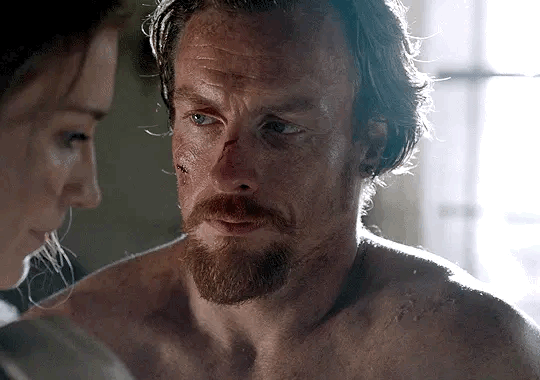
There’s been a lot of discourse about the nature of James and Miranda’s relationship. There’s even been a lot of discussion on my podcast about it. One thing I want to make clear is that my podcast is a platform for discussion on all points of view. I’m not going to agree, 100%, with everything that’s said, but it makes the views of my guests no less valid. There’s no right or wrong, here, because this is art and therefore, it is subject to interpretation.
My intent, however, is to attempt to get as close to the original intent of the actors as possible because we look at a show or a film or a play as going through several layers of distillation. Each level purifies the intended narrative leaving its truest essence.
When we make a reduction sauce using an alcohol of some kind, let’s say a red wine, the heat applied to it burns off things we don’t need for flavor. You’re never going to get drunk off of red wine reduction because there’s almost no alcohol left in it. That all gets burned off, leaving only the flavor components, which is what we wanted all along, anyway. We want that extra element that enriches the flavor of the steak, by adding nuance.
So let’s take apart that meal.
We start with the birth of the idea. The story kicks around in an author’s head, trying to get out, growing bigger and more persistent until it outgrows the confines of the mental box inspiration is stored in and has to be let out. That idea, that’s the cow.
The author raises that idea, feeds it, watches it grow, and then, ultimately slaughters it. That sounds awful, but once you have that idea pulsing, growing, evolving and then finally commit the final draft on paper, it is a kind of death. The life of the story comes to an end and it becomes memorialized in a mausoleum. Readers will come to visit, spend time with it, lay down flowers, cherish it, and mourn its passing.
The next level is adaptation. That’s the steak. There are many ways you can slice the story, large roasts encompassing the whole story or a smaller, hyper-focused character study fillet mignon.
A writers room gets hold of the cow and carves it up. They choose what gets cooked and what gets tossed. A GREAT group of writers saves the bones. They take in the entire supporting structure of the piece and while the whole story may not make it onto the screen, they will have slow roasted the bones for a stock. When you watch a show like Black Sails, where themes are introduced that won’t fully be explained or explored until several seasons later, that’s what that is. It is the stock being used to flavor the whole dish. You’ve distilled the entire cow to its purest essence and so every scene, every line of dialogue, every acting choice, encompasses the entirety of the story. A line from episode one is defined by knowledge of the finale and in regard to dialogue, defined by an actors’ knowledge of a character’s backstory. There are many writers rooms who are creating the bones of the story as they go, which means they aren’t starting with a rich stock. You can’t trace back character motivations or choices to begin with because those motivations changed throughout production.
Black Sails, again, isn’t one of those shows. Steinberg and Levine came into the writers room with their stock pot full and sloshing, spilling story everywhere. The richness of the details they were laying can make season one a bit hard to consume unless you are ready for a story on that level. Viewers need to come to the table with some bread to sop up all those character details because we WILL need them later.
Over the course of finalizing scripts and blocking out episodes, the steak is cooked. Like any great steak, this story is medium rare. More juice comes out with every bite. It’s what makes the show infinitely rewatchable. It continues to cook on the plate, but because it wasn’t overdone, it never dries out.
When the actors get ahold of it, that’s the reduction sauce we were talking about. That sauce provides nuance and flavor. That’s the emotion. A line of dialogue on a page is just ink. It’s nothing until it’s spoken aloud. And like any bit of language in this world, it’s subject to interpretation. In this case, it’s the actor who does the interpreting.
I spoke on the podcast about the art of subtext and how huge a role it plays in Black Sails. One example we used is Jane Eyre. It’s one of the most frequently adapted novels in the English language and with each adaptation, we get a new version of our characters. The most volatile and subject to change is Rochester. There are MANY versions of Rochester that I find appalling (including the original beast in the book), but each actor has formed him into something else, based on their performance. Toby Stephens takes Rochester and turns him into a silly tragic romantic, broken many times over by a society he never really fits into, despite the status of his birth. He connects with Ruth Wilson’s Jane because she fully and happily inhabits that space on the fringes that Rochester thinks he needs to climb out of. Jane takes his hand on the outside of the wall, turns him away from the guarded palace and shows him the wild world that was at his back this whole time.
This is what Toby Stephens, Luke Arnold, Louise Barnes, Zethu Dlomo, and really all the actors for whom their subtextual choices make them reflect like prisms, have done with their performances.
In the final distillation, character motivations and emotions are finalized by the actor. Writers can pontificate, the source material lies dead in its lovely tomb, but stories live and breathe by their storytellers.
What we’re left with is Toby’s face telling the world how deeply Flint loves Silver. Every single choice tells this story.
We’re left with Luke showing us how much Silver is repressing in his feelings for Flint. Luke’s face shows us an incredible depth of feeling and a door slamming shut.
We’re left with the incredible intimacy between James and Miranda, which speaks of a decade of shared physical intimacy. There’s an openness, a freeness to it until the moment in episode 3 when Miranda learns that James has found the Urca and is leaving soon to pursue it. She gives some of it away when she says “I thought I’d have you all to myself”. She is mourning the loss of intimacy that she only gets in short windows of time. They aren’t strained because James isn’t attracted to her, but because he’s rarely there. She has him for a few days at a time before he’s off on another hunt. The coldness starts from the moment he tells her he’s leaving in a few days because I believe she thinks he won’t be coming back, that this is the hunt he won’t survive and she’ll finally have lost both James and Thomas. From the moment Richard Guthrie darkens her door, she’s looking for a way to weaponize him and get them out. For her, it’s a race against the clock and she’s willing to sacrifice a bit of her relationship with James in the present to secure happiness for them in the future.
This is also why James still has sex with her before leaving, even though he’s furious for her reading Meditations to Richard. This is how they connect. They connected through physical intimacy in the flashbacks, as well. Him stroking her thumb in the carriage before the kiss. Tactile contact to seal their understanding of each other. Miranda bracing her hands on his chest during important moments in the Hamilton’s home, something she also does to Thomas, to show physical connection, physical intimacy. Miranda thrives on physical touch.
To think that, for 10 years, James is lying there like an object for Miranda to use, is, to me, short sighted. To think that James doesn’t love Miranda outside of a group, is also ignoring the fact that, 10 years on, James will not leave on a hunt (angry as they both are) without physically connecting with her, trying so hard to reach beyond his anger and the wound freshly opened from sight of that book he’s chosen not to look at for probably the better part of those 10 years. The way his hands hover over her back after she comes and he desperately wants to be with her in that moment, like the best of their moments, but he just can’t, speaks to the depth of his love for her.
So many fans of the show point to this sad sex scene as one of the most important character moments for James and Miranda, but I consistently come to the opposite conclusions about WHY it’s important and what we learn from it, because I’m taking my cues from the actor’s choices, not the director or the writers. On the page, in plain ink, he hates having sex with her. Toby and Louise show us, however, that they are trying to recapture a thing that is fleeting, reaching out to each other to patch up an old wound from which the scab has been picked off, leaving it seeping and raw.
From Toby’s performance, regardless of the words he uses years later to describe it, we see not a character who “loves men” or a character who “loves women”, but a character who LOVES. I don’t see Flint defining that love in terms of boxes and parameters. He’s a character who must be coaxed out, but then loves without reason, without a safety net, as he proves with his love of Silver. As was also referenced by a guest on the podcast, he places a sword in Silver’s hand and says “do it”.
Anyway, this post got away from me and took several turns, but the love between James and Miranda being dismissed by so many in the fandom has been bugging me for a while and I just needed to emotionally vomit on tumblr.
#black sails meta#cooking metaphors#my culinary degree isn’t ALWAYS useless#James Flint#Captain James Flint#James McGraw#Miranda Barlow#John Silver#flinthamilton#SilverFlint#silverflintmadi#Toby Stephens#Louise Barnes#Luke Arnold#Zethu Dlomo#Black Sails#sexuality in a historical context#the almighty subtext#acting choices were made#When the lips and the eyes are telling two different stories it’s the eyes that tell the truth#no daylight between you and I
187 notes
·
View notes
Note
Script writing is a very personal process and I've seen you answer asks about your scripting before, I'm just curious about how much detail you need to add to your scripts in order to feel like it makes sense.
A friend of mine and I are working on a small project and I'm currently writing the script for it but I'm finding it hard to write all the detail that's necessary, do you find that drawing out what you have scripted adds more to what you initially plan?
How many drafts does it take to finalise the scripting of each page or does that vary from page to page?
Do you change dialogue a lot? And are you able to get into each character's head to understand how they'd react to certain situations?
Sorry if this is a lot, I hope you have a good day! :D
a very important element of script writing (when it comes to writing a script that other people will have to read in order to make the final product) is not giving too much information. the people youre working with more than likely know what theyre doing and can be just as creative as you, so as the script writer you should tell them what you NEED. sometimes you need to go more into detail if those details become relevant. who knows, those might be chekhovs runic symbols! and sometimes theyre just set dressing (not worth describing in the script).
in general, as long as youre covering every detail required to make the story make sense, youre good. scripts are not the place for pretty imagery, theyre for the basic required information to be expanded on later on in the process. if theres a gun on the table, you may need to just say "theres a gun on the table," or you may need to specify that its a pistol, it all depends on what the story needs to be true.
when im drawing out my scripts, i inevitably end up adding a whole lot of material (or retroactively deciding certain details dont matter and i can cut them for ease of drawing) because thats just what ends up happening when you turn a basic description of a room into a room you see with your own eyes. and because the script is always in flux, i can even add dialogue that i realize would be funny when drawing (theres a visual gag on the next page thats referenced in dialogue, said dialogue was added after i finished the sketch)
i dont write a specific number of drafts for specific pages (nor do i know where the pages will start and end before i begin the thumbnailing phase), the whole chapters script just remains in editable form until the pages go online. there was a point where i added dialogue to a page 2 days before it was supposed to be uploaded.
hot tip here: never say a script is "finalized," ever. EVER. it will NEVER be true. musicals on broadway STILL get edited, webcomics will have pages changed or added AFTER a page is up to clarify the subject of the audiences confusion or missed implications (rarely happens but it does). scripts are always, always, always editable*.
(*in theatre, when youre doing a workshop/production of a show you wrote, there might be a point in the process (usually around tech week or opening night) when your script gets "frozen," which is production team language for "please, were begging you, stop changing this, we cant keep redoing these cues, please, god, think of the stage manager". its not unusual for scripts to continue to change throughout the performances though)
and yes, i do change dialogue a lot. when i start writing a character, it may take me a while to really Get them (cough cough phil), which is why revisions are great, so i can retroactively make a character act in the right way after ive had enough time to figure them out. there are some characters that i get so well that it feels like there is a portion of my brain dedicated to emulating their behavior, particularly flynn, leon, vermillion and lucille. viridian and violet are quickly building their own zones too.
however, dialogue isnt just about staying in character. dialogue serves a function. jokes need to be funny, conversations need to get through all their beats, etc. the first draft of dialogue may be the most in character, but it will more than likely serve its function less. because of this, its very easy to write dialogue thats LONG (real conversations are typically very long), but its very difficult to write dialogue thats SHORT (serving its purpose quickly and efficiently).
the way i do this is that i write the scene, however long it ends up being, then identify the significant points it goes through. once ive done that, i can cut material between those points (with natural scenic flow in mind) such that the scene becomes streamlined, going through all the necessary beats as efficiently as possible.
its important to not enter too utilitarian a mindset for this though! sometimes a piece of dialogue is frivolous at best but you just like it a lot. keep it! filler can be a nice experience even if it doesnt accomplish anything. that "and if anyone offers things like drugs or alcohol dont take them up on that" joke in chapter 2 couldve been easily cut, but the way i reused it pages later was WAY too funny to me, so i kept it anyway! i even recently ADDED some frivolous dialogue to a scene in a later chapter simply because it added a character detail that i enjoyed, simple as that!
4 notes
·
View notes
Text
NaLu analysis: Hype Vs. Hype?
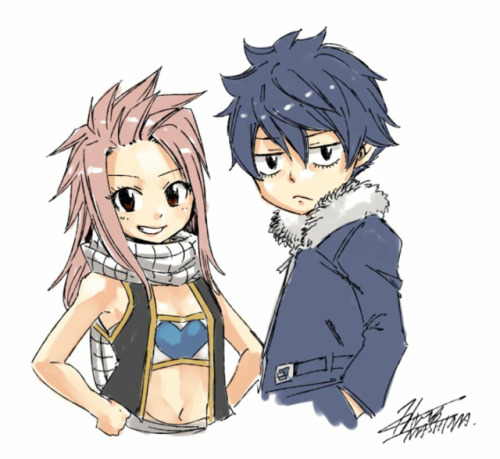
After getting NaLu crumbs too small to make a proper analysis about them, chapter 65 of the sequel is giving us a lot of material!
Whether fans and/or shippers realize it or not, this subject is pretty relevant for their respective fandoms. The excitment, and the anticipation surrounding current scenes or future events in their favorite stories is something that gets them invested in manga/anime.
When it comes to pairings, there are two kinds of hype. There's the hype created by the way a story unfolds, and there's the fanhype, which consists of fans getting overexcited and blowing things out of proportion because their favorite character(s) did something...
If we talk about the first kind, Fairy Tail is now a special case given the author's twitter activity.
Back in 2017, Mashima made a draft of NaLu's daughter, and later twitted a finished version of the possible children of both NaLu and Gruvia. At that time, they weren't part of the official story. But, chapter 65 of the Fairy Tail sequel changed that a little bit...

...Team Natsu is back at Edolas, and they found out their (now older) alternate versions married with kids: Edo Natsu and Edo Lucy had "Nasha"
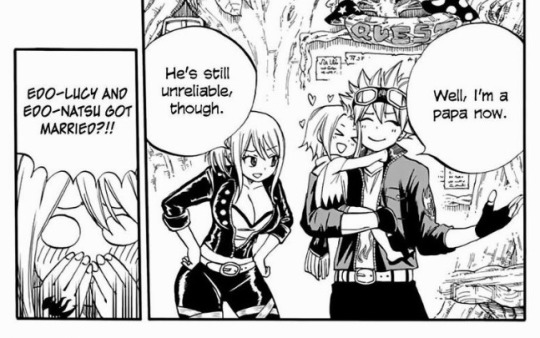
While Edo Gray and Edo Juvia had "Greige," the Gruvia son:
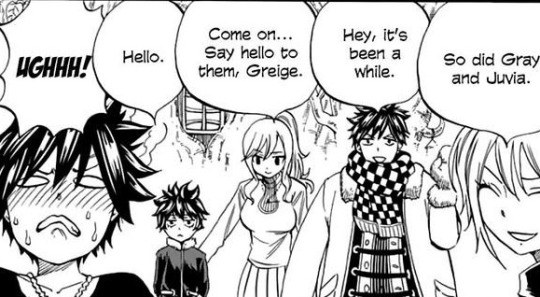
Why did the Edolas version of NaLu and Gruvia give us offspring, while Earthland Lucy is still embarrassed at the prospect of a romantic relationship with Natsu, and Earthland Gray is pretty embarrassed about having a kid with Juvia?
After the events of the Tenrou (Sirius) Island arc, Most of the main cast of the titular guild spent 7 years "frozen" in time. Meanwhile their Edolas counterpart didn't undergo such a experience, so they're 7 years older thatn their Earthland counterparts, and then and during that time span, Edo Natsu and Edo Lucy married and had Nasha.
But, several readers probably figured that much. So, what does this have to do with hype?
Well, we know the author had been making a lot of NaLu twits...
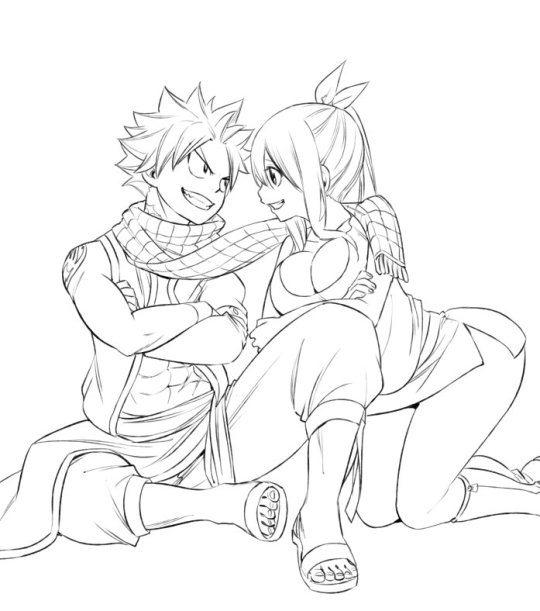
...and he’s been doing it for ages, long before the idea of a manga sequel.
Flashfoward to chapter 25, and we get introduced to Fairy Nail. An alternate version of the Fairy Tail guildmembers, in which Nack (Natsu's counterpart) and Lucia (Lucy's counterpart) are in a very spicy relationship. And Gruvia is canon there too.
Now, we got to chapter 65, and we see Edolas NaLu happily married with a child. There’s a clear pattern here, but the Edolas version of the pairing brings something new to the table
If we take into consideration the fact Edolas didn't have an Acnologia-like event, we can conclude that during the span of those 7 years, each relationship evolved, reached marriage, and had kids who may be within the range of 5-6 years of age. You can probably figure out where am I going with this
While it's true that only two alternate versions of NaLu are canon, if we combine all of these elements, and all this teasing, we see that Mashima had been building anticipation in the readers. He's creating hype
If we factor Gruvia, the fact Gray already admits he wants to improve so he can be with Juvia shows we're getting closer to the relationship upgrade their Edolas counterparts had, which probably happened 7 years ago. What makes this so hype is how it revolves around the story put into context.
How is this different from fanhype? While this NaLu and Gruvia hype had been deliberately created by the author himself. Fanhype exists because of the exaggeration of interactions and moments without any actual meaning.
This kind of hype is developed by those who wank their favorite character and/or premise, blowing everything around them out of proportion.
And chapter 65 not only gave us NaLu/Gruvia hype. It also has a couple of panels that several wankers exaggerated as something romantic for a pretty weak premise.
When Team Natsu returned to Edolas, Lucy found herself completely naked, and Gray offered his coat so she could cover herself...
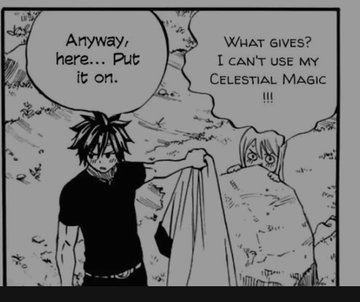
...this panel was hyped as a romantic gesture even by several NaLu shippers. But, is it really something unique or special?
It's certainly not unique for we've already seen Lucy far more often with Natsu's clothes in the manga:
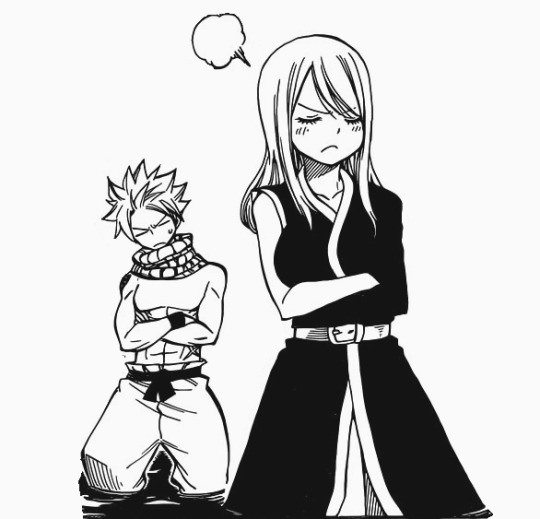
The sequel:
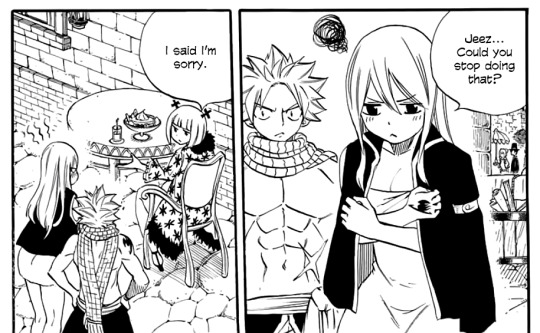
And even in Mashima's twitter:
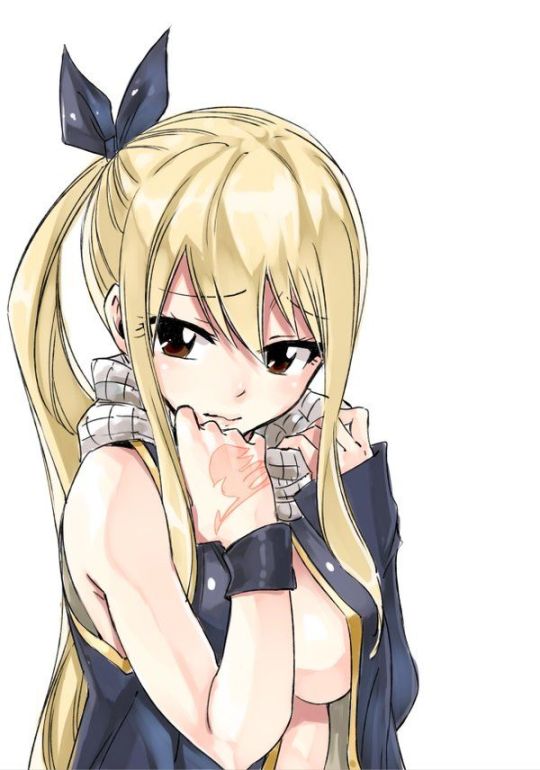
So, it's not something unique. Still, shippers couldn't care less about these other moments; they prefer to build their own hype around Gray's coat while completely dismissing the fact NaLu's daughter (and Gruvia's son) became part of the story.
The coat is not the only thing shippers love to wank. They relished on Gray blushing when hearing Lucy was naked, and claimed his reaction is a proof of his desire for Lucy. An argument that completely ignores the characterization, story, and context provided until now
Let's backtrack to the chapter 26. Right before making the promise to improve himself for Juvia, he had a strong reaction at seeing the naked body of Juvia's lookalike, not only he was blushing, he was also far more expressive here:
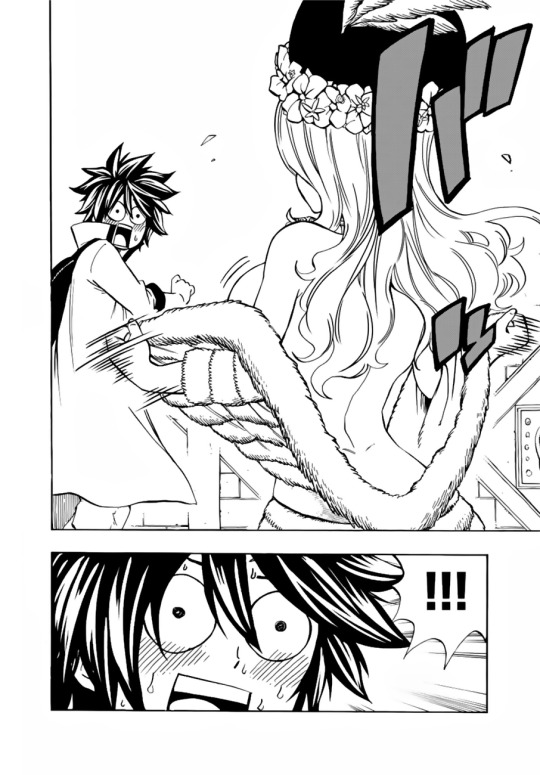
I can even mention shippers using commonalities or one-chapter gags to try proving their premise is valid. But, that would be overkill. And that leaves one final question: difference between story-based hype and fanhype?
Hype created by the author is based on the progression and/or development of one or multiple elements within their work's narrative.
While fanhype is based around moments taken out of context and blown out of proportion.
That's why the Nasha/Greige hype is real, and the hype created by shippers is only a bunch of headcanons foreign to the story.
#fairy tail#fairy tail 100 years quest#chapter 65#nalu#natsu x lucy#gruvia#nasha dragion#greige surge#hype vs hype#analysis#recently edited
252 notes
·
View notes
Note
How about those JL storyboards?
In case you haven’t heard, Zack Snyder is putting on display the ‘storyboards’ - i.e. a rough plot summary accompanied by some Jim Lee sketches - for what would have been Justice League 2 and 3, or as this puts it 2 and ‘2A’. You can see them here (I imagine better-quality versions will soon be released), and read a transcript here. This is evidently a very early version: this was apparently pitched prior to the release of BvS and Justice League being rewritten in the wake of it, with numerous plot details that now don’t line up with what we know about the Snyder Cut, plus it outright mentions it builds on the originally planned versions of the Batman and Flash movies. But it’s a broad outline of what was gonna go down, and while I initially thought it was Snyder throwing in the towel, the timing - paired with the ambiguity left by the necessity for changes, including that this doesn’t factor whatever that “massive cliffhanger” at the end of the Cut is - says to me he’s hoping this’ll be a force multiplier behind efforts to will sequel/s into existence. He’s probably right.
I’ll be discussing spoilers below, but in short: with this Zack Snyder has finally lived up to Alan Moore, in that like Twilight of the Superheroes I wouldn’t believe this was real as opposed to a shockingly on-point parody if not for direct, irrefutable evidence.
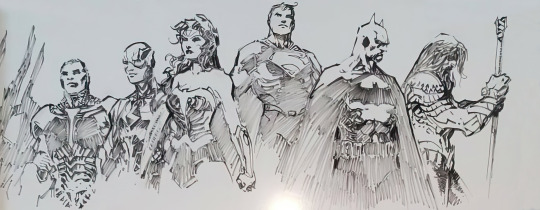
Doing some rapid-fire bullet points for this baby to kick us off:
* Folks who know the subject say a lot of this is a yet further continuation of Snyder doing Arthuriana fanfic with the League reskinned over those major players, and I’ll take their word for it.
* I don’t know whether I love or hate that in Justice League 2 the Justice League are only an extant thing for the first scene, and then it’s Snyder giving everybody their own mini-movies. It’s compressing the entire MCU “loosely interconnected solo stories leading to a single big movie later” strategy into a single movie!
* Funniest line in the whole thing: "Even Lantern has heard of the Kryptonian, worried that he's under the control of Darkseid. He heard his spirit was unbreakable." Hal what fuckin' Superman movie did YOU watch? Second funniest being “IT WILL GIVE HIM POWER OVER ALL LIVING LIFE”
* 90% of the plot I have nothing to say about, it’s generic stage-setting crap. That to be clear is the ‘shocked it’s Snyder’ element, it feels so crassly commercial in a way I can’t believe is coming from the BvS guy.
* Most of what I have to say is unsurprisingly gonna be about a handful of characters but Cyborg’s happy ending being “he isn’t visibly disabled anymore!” is not great!
* The Goddess of War battle with Superman...never pays off? No clue why it’s there.
* What I’d originally heard was that the Codex in Superman’s blood was the last key to the Anti-Life Equation and that’s why Darkseid was coming to Earth. It’s not like all of this wouldn’t have already been averted by Kal-El’s pod smacking into an asteroid on the way to Earth so it’s not as if this makes it any more Superman’s fault, and it would have at least tied all this back to the beginning of the movies, but I suppose that was either fake or from a later draft.
* I have NO idea how this was reimagined without the ‘love triangle’, it’s the central character thing and the entire climax flows directly out of it!
* Darkseid’s kinda a chump in this, huh

Anonymous said: So: Does Zack Snyder hate Superman?
Look: the hilarity of this when Cuck Kent has been a go-to Snyder cult insult towards ‘inferior’ takes on Superman for years cannot be understated, yet at the same time I can almost wrap my brain around where Snyder’s coming from with that as the end for his take on the character. He talked in that Variety piece on how his interest in Superman is informed by having adopted children himself, and Deborah Snyder is the stepmother to his kids by previous relationships, so I can see where he’d be coming from, and I can even imagine how he’d see this as ‘rhyming’ in the sense of “the series begins with Kal-El being adopted by Earth, it ends with him adopting a child of Earth!” In the same way as MARTHA, I can envision how he would put these pieces together in his head thematically without registering or caring what the end result would actually look like. In this case, Superman raising the kid of the man who beat the shit out of him who Batman had with Clark’s wife, who earlier told Bruce she was staying with Clark because he ‘needed her’, suggesting if inadvertently that this really honest to god was a “she’s only staying with Superman out of pity, she really loved Batman more” thing.
But Clark is nothing in this. He’s sad and existential because of coming back from the dead I guess, then he’s corrupted, then time’s undone and he woo-rah rallies the collective armies of the world (interesting angle for the ‘anti-military/anti-establishment’ Superman he’s talked up as) as his big heroic moment in the finale, and then he stops being sad because he’s adopting a kid. So his big much-ballyhooed, extremely necessary five-movie character arc towards truly becoming Superman was:
Sad weird kid -> sad weird kid learns he’s an alien, is still weird and sad, maybe he shouldn’t save people because things could go really wrong? -> his dad is so convinced it could go wrong he lets himself die -> ????? -> Clark is saving people anyway -> learns his origin, gets an inspiring speech about being a bridge between worlds and a costume -> becomes superman (not Superman, that’s later) to save the world, albeit a very property-damagey version, rejects his heritage he just learned about and space dad’s bridge idea -> folks hate him being superman and that sucks though at least he’s got a girlfriend now -> things go so wrong he considers not being superman but his ghost dad reminds him shit always goes wrong so he should be good anyway, which sorta feels like it contradicts his previous advice -> immediate renewed goodness is out the window as he’s blackmailed into having to try and kill a dude but the dude happens to coincidentally have some things in common so they don’t kill each other after all -> big monster now but superman keeps supermaning at it because he loves his girlfriend and he dies -> he’s brought back, wears black which apparently means now he likes Krypton again? -> he has work friends now but he’s still sad because he was dead -> evil now! -> wait nevermind time travel -> rallies the troops -> his wife’s having a kid so he’s not sad anymore -> Superman! Who gives way to more Batman.

Do I think Zack Snyder is lying when he says he likes Superman? No. I think he sincerely finds much of the basic conceits and imagery engaging. But I don’t think he meaningfully gives shit about Clark as a character, just a vessel for Big Iconic Beats he wants to hit. Whereas while for instance he’s critical of Batman as an idea (at least up to a point), he’s much more passionately, directly enamored with him as a presence and personality. So while Superman may be the character whose ostensible myth cycle or arc or however it’s spun might be propelling a lot of events here, it’s a distant appreciation - of course the other guy takes over and subsumes him into his own narrative. Of course Batman is the savior, the past and the future (though if he’s supposed to be Batman’s kid raised by Superman there’s no excuse for him not to be Nightwing), the tragic martyr to our potential. Admittedly the implication here is also that Batman can apparently only REALLY with his whole heart be willing to sacrifice his life to save an innocent, for that matter apparently his great love, once said innocent is a receptacle for his Bat-brood, but he and Clark are both already irredeemable pieces of shit by the end of BvS so it’s not like this even registers by comparison.
Anonymous said: That “plan” Snyder had was utter dogshit. Picture proof that DC & WB hate Superman. Also I love how you’re like Jor-El: Every single idealistic take you had about Snyder, his fandom, and BvS was wrong. Snyder’s an edgy hack, his fanbase just wants to jerk off to their edgy self-insert Batgod as he screams FUCK while mowing people down with machine guns, and the idea that BvS said Superman was better than Bats was completely wrong. You know what comes next SuperMann: Either you die or I do.
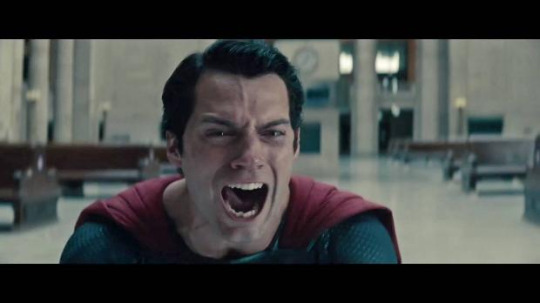
In the final analysis, beyond that mother of god is there sure no conceivable excuse for the treatment of Lois in this? The temptation is to join that anon and say as I originally tweeted that these were “built entirely to disabuse every single redemptive reading of the previous work and any notion of these movies as nuanced, artistic, self-reflective, or meaningful”.
...
...
...yeah, okay, that’s mostly right. Zack Snyder’s vision really was the vision of an edgelord idiot with bad ideas who was never going to build up to anything that would reframe it all as a sensible whole. He’s a sincere edgelord genuinely trying really hard with his bad ideas who put some of them together quite cleverly! But they’re fucking bad and the endgame was never anything more than ramping up into smashing the action figures together as big as he could, the political overtones and moral sketchiness of BvS while trying to say something in that movie reverberated through the grand scheme of his pentalogy in no way beyond giving his boys a big sad pit to rise out of so when they kicked ass later it’d rule harder, and all the gods among men questions and horror and trappings were only that: trappings. Apparently he’s really pleasant and well-meaning in person, but at his core his art as embodied in a couple weeks in his 4-hour R-rated Justice League movie meant to be seen in black-and-white all comes down to that time he yelled at someone on Twitter that he couldn’t appreciate Snyder’s work because it’s for grown-ups. He made half-clever, occasionally exciting shit cape movies for a bunch of corny pseudo-intellectual douchebags, folks latching onto and justifying blockbusters that at least acknowledge how horrifying the world is right now even if the superheroes are basically useless in the face of it if not outright part of the problem until a convenient alien invasion shows up to justify them, and a handful of non-asshole smart people who vibe with it but...well. ‘Suckered’ is a harsh word, and definitely doesn’t apply to all of them re: what they’ve gotten out of it up to this point and would (somehow) get out of this. But it doesn’t apply to none of them, either.
60 notes
·
View notes
Text
How to Post your Works to the SQSupernova Collection!
That’s right - it’s almost time for Authors and Artists to put their beautiful works on display! We’ve made our beautiful, wonderful guide to help you post your work successfully - please read it THOROUGHLY before asking questions! We promise we’ve covered almost anything that could cause issues.
The posting deadline for all works is midnight EST on August 30th!
(What time is that for me? Or, check out our Countdown Timer!)
For those of you with experience posting to the Swan Queen Supernova collection from previous years, this year’s collection can be found HERE - just hit the ‘post to collection’ button and away you go!
Quick reminder - don’t forget to click POST when you are done formatting your work, NOT ‘save as draft’! We will not be able to see or reveal your work if you save it as a draft, and it will not count as being submitted!
For those of you who need more assistance as you prepare to post, read on for more specific instructions:
All right! For those of you who would like further clarification, your first step will still be to go to THIS LINK and click ‘Post to Collection,’ as seen below.

On this next page, you will enter all of the information about your fic/art - starting with rating, warnings, fandom, category, relationships, and characters. A sample page would look like this:
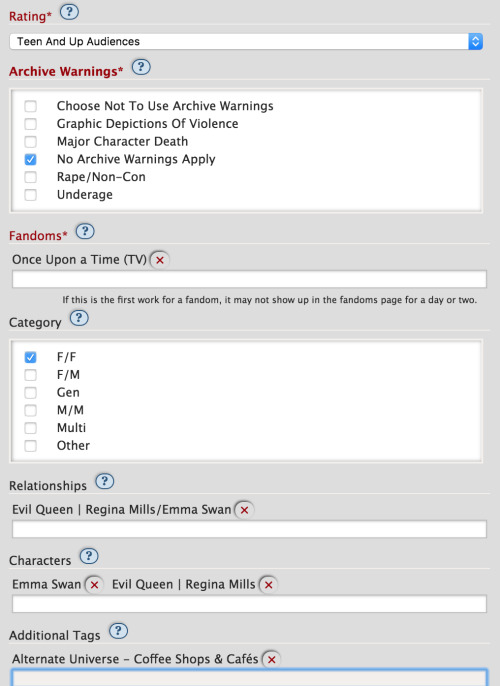
Please make sure your rating and warnings are accurate to your fic/art. If you think a warning might spoil something for the plot, you can select ‘Choose Not to Use Archive Warnings.’ Do NOT select ‘No Archive Warnings Apply’ unless your fic/art truly does not have any of the warning elements present in it.
The Additional Tags section is a place to put anything else you feel should be indicated about your story/art. Is it a historical au? Does it take place on a spaceship? Is it fluff? angst? crack? These tags are optional, but many people do use them to organize their fic/art or to find new fics to read and art to appreciate.
Next up is the preface section - this is how you introduce your fic or art!

Authors - you’ve already sent us a title and summary, so if those still work for you, go ahead and just copy them right in there! If you’ve changed some things up since that submission, go ahead and put your final version in here.
Artists - whatever title you use, it’s probably a good idea to add [Fanart] or [Art] to the end of your title, and to tag it as such in the additional tags as well - this will help people find art specifically!
Notes can be posted at the beginning of the fic - like if you are thanking a beta, or blaming someone for making you do this, or giving introductory notes to the readers about setting, etc - or at the end of the fic, if your notes might spoil part of the plot. You can also check both boxes and put notes in both places!
Now for the fiddly bits:
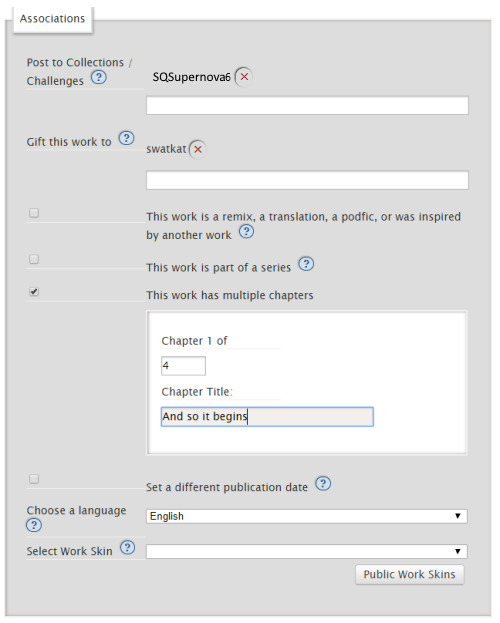
The first, and most important, thing to check is that under Post to Collections / Challenges, ‘SQSupernova6′ is selected. This should automatically show up, since you used the ‘Post to Collection’ button, but please check anyway!
You can also choose to gift your fic to someone - authors may choose to gift their fic to their artist, or vice versa. You should have their AO3 name from your match-up email!
‘This work is a remix, a translation, a podfic, or was inspired by another work’ - this will be a handy section to connect your fic to your artist’s art, but you won’t be able to use it until after reveals. Skip it for now and come back to it later, once your partner’s work has been revealed!
‘This work is part of a series’ - if your SQSN was part of a series that you have already begun, you can link it to the previous parts here. Otherwise, skip it.
‘This work has multiple chapters’ - If you’d like to split your work up into chapters, select this option. Once you post the first chapter, you will be able to add additional chapters from the first chapter of your fic/art.
‘Set a different publication date’ - DON’T DO ANYTHING WITH THIS NOW. LEAVE IT ALONE. You will receive instructions in your reveal date email about how to change this date later, to help ensure that it shows up at the top of the Swan Queen tag, so you get the most eyes on it. You cannot change the date BEFORE the date of your reveal, so leave this field alone for now.
You’re almost there! First up are some privacy questions:
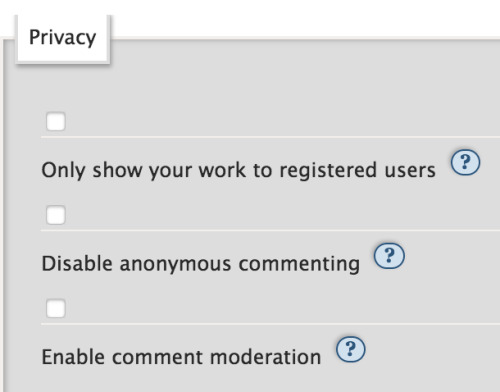
These are all options that can make it harder for people to leave mean or abusive comments - but they also make it harder for commenters without accounts to leave feedback, so consider the pros and cons before selecting!
And finally, it’s time to input your fic or art!

For fic - if you are comfortable with html coding, feel free to use the HTML editor button in the top right to switch editing boxes. Otherwise, the Rich Text editor will let you do most basic word editing functions, and will maintain bolding, italics, etc pasted in from Word or Google Docs.
For art, you will need some words in the post itself in order to post, so be sure to add a sentence or two about your work, then select the insert/edit image button:
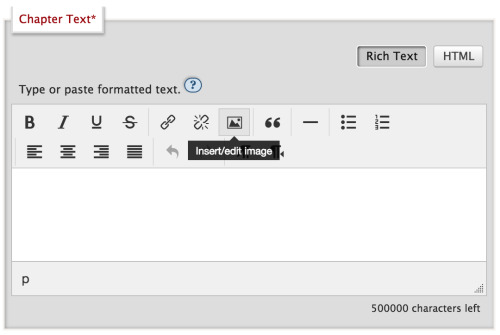
It will bring up this menu:
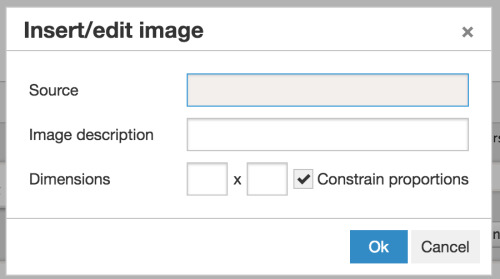
Source - this is where you should paste in the url of the image you are hosting on another private site - so don’t publicly post it to your Tumblr! Use a PRIVATE post, at least until reveals are over. For a list of recommended sites, check out AO3′s helpful article on the subject!
Remember that your image URL needs to end in a filetype, like .jpg, .png, .gif, etc etc.!!! IT WILL NOT WORK IF YOU DO NOT HAVE A FILETYPE AT THE END OF YOUR URL. Your image will NOT appear if your link ends in .html, /, or any random numbers or letters.
Image description - this is very important for people who use screen readers because of vision impairments. Please describe your image as best you can, for example: this is a four-panel cartoon of Emma Swan, a barista, tripping over a chair and spilling hot chocolate down Regina Mills’ shirt. Regina is in a fancy blouse and skirt, and looks very, very pissed off.
Dimensions - if your source image is very, very big, it is recommended that you shrink it down a bit here. You can always come back and play around with the size once you post, so be sure to check that your image isn’t so big it’s hard to see all of it on a normal computer screen.
Aaaaaand, you’re done! If you’re confident everything is correct, you can click ‘Post Without Preview’ (you daredevil, you), but otherwise, click ‘Preview’ and give your story a quick glance over to make sure everything’s in the right place.

Then, once you’re satisfied, just make sure you click POST on the next screen - this is the only way to submit it to us for the collection!

If you don’t click ‘Post,’ your work will stay as a draft and will NOT be counted as submitted! Please make sure to hit POST once you have everything ready.
Once you post your work to the collection, it immediately becomes an unrevealed work. This means that its details are hidden from everyone but you and your beloved mods! Unfortunately, this also makes it a liiiiittle harder to find.
To locate your work once you post it to the collection, go to ‘My Dashboard’ by clicking on the menu that appears when you click on your username in the top right corner of the page, then click on ‘Works’ on the left-hand side.
From here, you can access your hidden work in one of two ways:
Click ‘Edit Works’ on the upper right side of the page. This will let you view all of your works, sorted by fandom, including the one you just submitted to the collection. Click on the title of that work to continue editing it!
Once your work is approved and added to the collection, you can also click ‘Works in Collections’ on the upper right side of the page. This will display all of your works that are currently in collections, sorted chronologically. Your SQSN work should be at the top, with “Unrevealed:” in front of the title. Click on the title of that work to continue editing it!
The URL of your work will also not change once you’ve clicked ‘post,’ so you can also bookmark or save it to come back to at any time.
If you need to add additional chapters to your work, you can do it by going to that URL or locating your fic again as described above, and clicking this link on the first chapter:

Just make sure to press POST on each additional chapter as well! ;D
--------------------
Congratulations! You’ve just Supernova’d! What a rush, eh? Now just lean back, relax, and wait for reveals. Thank you for participating!
Each creator will get an email letting them know the reveal date for each work they have submitted, at least a few days before the date, so that they can prepare and get their friends hyped up for the reveal! If you hear other people getting their emails and you haven’t yet, don’t panic. There are WEEKS of reveals, so some people get emails very early and some people get emails weeks later. We PROMISE everyone will get an email with their reveal date by the time all is said and done!
If you have any questions, feel free to contact us at @SQSupernova on Twitter, or at [email protected] !
6 notes
·
View notes
Text
85. Among the Hairy Earthmen
A mescalanza is, in Spanish, a “medley” or a “potpourri” or a “miscellany.” In Italian (as mescolanza), it’s any sort of mixture, often a mix of people or of ideas. Either way, it’s a collection of disparate elements that combine to form something greater than the individual parts could ever have been alone; often, the combination brings out aspects in the originals that no one could have predicted.
The earliest extant drafts of “Among the Hairy Earthmen”—which for a good while went by the name “The Long Afternoon,” though others were considered—imply that the story was developed as just such a mescolanza, in much the same way as the later “Nor Limestone Islands” would be a lapidary work, or the later still “In Deepest Glass” would be a cathedral window. (Or further, in the way that almost every Lafferty work contains some sort of image of its own processes of inscription.)
Certainly this draft seems to be the first short story that really piled on the epigraphs—a fixture of Lafferty’s novel writing from the first, and very present just then from his work on Archipelago, but which he had been more reticent to deploy in shorter stories. What’s more, it may well be the first mention of “The Back Door of History,” that compendium of shadow historiography that provides excerpts for many a Lafferty tale—and it’s the author of this work who introduces the word mescolanza, though in this early stage the pseudonymous author is listed as Arpad Dotch, not Arutinov. The narrator of the story cites four epigraphs in all, alternating Lafferty inventions from “The Lighter Side of Geology”—by one A.E.C. Copps, who does not recur—and “The Back Door of History” with two actual quotations from John Addington Symonds’ magisterial history The Italian Renaissance and Frederick Rolfe / Baron Corvo’s History of the Borgias. (These two British eccentrics were quite different in most ways save one: they were both about as openly queer as it was possible to be in the societies of their time.)
There’s indications that a Chesterton quote may also have been part of the miscellany—something I think he would appreciate—but none of these quotes made it to the final draft; they were all removed amid extensive rewrites trying to get the story to the point that Fred Pohl would buy it. In a letter from February 1964—after Lafferty had already rewritten the story multiple times, including earlier in the month—Pohl notes that “you have something interesting, entertaining and stimulating to say, but because you say it in a jackdaw’s-nest of unrelated bits of scenes and snippets of history you make it hard to read. … my quarrel with THE LONG AFTERNOON is that it is an easy story which you have written in a hard way.” It would seem that the number of quotations has only grown since the first draft, and Pohl admits himself bewildered: “But do you really need the quotations? From the first you only take the words ‘from Byzantium’; and take them only to deny them—but you have thrown twenty-odd data at the reader; since he does not know which are important, he tries to hold them all in his head, and when he finds out that by-God none of them are, he grows to dislike your story.”
Pohl made a further suggestion—“Suppose you rewrite the story, without quotes, in some consecutive form—perhaps as a narration”—which Lafferty carried out, which is why we have the story in the form we do. The “easy story” Pohl wanted to highlight is still complicated, a synthesis of readings across a huge number of historical subjects in the 13th to 15th centuries, but at root it is a story of alien visitation, of the subvariety where the aliens accelerate human development at a particular place in time; Lafferty’s innovation is to place this in medieval Europe rather than in Pharaonic Egypt or Attic Greece or for that matter the future. The story zeroes quickly in on the children at their arrival and follows their activities over the two-hundred-odd years which saw the Renaissance kindle and burst into life, up until they leave on the heels of a disciplinary thrashing from a mysterious human pilgrim. There still isn’t really a plot, but there is a “continuity” to proceedings—or enough to satisfy Pohl, at least. And some parts of it are vastly improved between the first draft and published versions.
And yet I still wonder about the version that could have been: the hard-way story, the jackdaw’s nest, the mescolanza. It would’ve been yet another work of Lafferty’s that embodied the formal experimentation of the New Wave, years before editors like Moorcock and Knight and Carr and Goldsmith—and Pohl himself!—commissioned and championed them. What “The Long Afternoon” lacked in continuity, it could have made up in innovation, inviting the reader into a wholly different role than just the receptor of a narrative: by throwing all these selections at the reader, making them distinguish between the real ones and the invented ones (see, always see, Don Webb on this technique), Lafferty press-gangs his audience, turning them all into fellow researchers, sifting through textual evidence. And if the reader ends up uncertain which data are or aren’t important, or uncertain of the entire enterprise generally, then Lafferty has already succeeded by muddying the epistemological waters sufficiently that the “aliens spearheaded the Renaissance” theory no longer seems fanciful—or, at least, no more fanciful than the idea that humans just up and did all those things on their own.
It’s not as if “Among the Hairy Earthmen” is a bad story. There’s a lot to investigate within it, and quite a few interesting questions to ask—maybe if I can ever get an actual medievalist to read the tale, I can get more and better answers than my own scanty reading on that period allows, but at the very least: What do we make of the story’s implication that humanity may be better off without such periods of frantic activity? (Note the ultimate sterility of the rapid society in “Slow Tuesday Night”; though also contrast the rich fecundity of the sped-up science types in “Brain Fever Season.”) Who is that final Pilgrim, and how did he come to the knowledge of the children’s interventions? Are those same children, as implied, back for another long afternoon; and if so, what dubious gifts are they giving us now? And yet, it’s undeniable that the effect of such questions is different when they are handed directly to you by the narration, rather than when they emerge from your navigation of Lafferty’s peculiar bricolage. (On this, see Gregorio Montejo, in Feast of Laughter 4).
The archive does not record whether Lafferty genuinely thought the story better in Pohl’s preferred format, or if he just went along with it because it was the only way it was likely to see print. If the latter, then it doesn’t seem to have affected his other stories much; the following years would see Lafferty send out many more formal experiments, including “What’s the Name of That Town” and “Primary Education of the Camiroi,” both composed during these same months that he was rewriting “Among the Hairy Earthmen” (and both, moreover, bought by Pohl). But I have to wonder if the ordeal didn’t at least color his view of Pohl, perhaps even mark an early stage of the process whereby the editor who, in Lafferty’s own words, “picked me up out of the scrap pile” became the editor who “was never right, but sometimes he was pretty insistent.”
Completed December 1961. Rewritten March 1963, December 1963, January 1964, and twice in February 1964. Published in Galaxy, ed. Frederik Pohl, August 1966. Collected in Ringing Changes. New York: Ace Books, 1984.
Next entry: "Crocodile," a dystopian tale about printing that had to go to press twice because they forgot a page
6 notes
·
View notes
Text
Earth, Wind, and Coffee: Chapter One Analysis
helloooooooo :) welcome to my chapter analyses for my fic Earth, Wind, and Coffee. here, i’m just going to be breaking down my writing process, choices, and fun stuff, among other stuff as well. you can read this after you’ve finished the first chapter (i’ve excluded spoilers!) or you could read all 45k words and then come back to these one by one. either way, i’m v excited to be doing this so i hope you guys like it too. lets begin with chapter one, shall we :)
some fun stuff before we start!
every chapter title is modeled after the fic title!
you may have noticed that there are two center line dividers in the chapter(and every chapter after), meaning there are three sections to a chapter. going off of this, i thought it might be cool to title each chapter based on the sections, either of its main topic or my favorite part of it. so, chapter one’s first section is korrasami meeting (hence, Meetings), section two is where i introduced Artist!Korra, and i really love Artist!Korra so naturally i had to name the chapter about her (and the thing that brings korrasami closer, Sketches), and the third section is where their friendship is solidified (i think i achieved this by giving their numbers to each other, but i also just thought it was a cute scene, Phone Number Exchanges) and now we put it all together and get: Meetings (Earth), Sketches (Wind), and Phone Number Exchanges (and Coffee) (pretty cool right??? *wink wink*) the same formula is used to title every chapter afterwards. i usually suck at chapter titles but i thought this was a super cute thing to do and it ended up working fairly naturally :)
i started this fic on sept 23, 2020. chapter one didn’t get posted until oct 15, 2020
so basically, i sat with this first chapter for almost a month before posting (which actually was a good thing, i’ll tell you why later!) i really wanted this first chapter to stand out and be lowkey perfect, so i kept writing and rewriting and rewriting my rewrites. then you know, i’d start reading and then edit and then edit the edits; it’s a vicious cycle but one that i’m used to. i finally decided to post the fic when i read the first chapter through and thought “yep, this is it”
i was inspired by the fic it’s such a gorgeous sight to see you in the middle of the night by softshocks
mostly for the idea of having a full-length fic in only three chapters. buuut, that was also one of the first korrasami fics i read after finishing lok on netflix and i remember thinking “damn, now THIS is how you do an au” character progression in the story is great and not once during the fic did i feel bored or in a lull. i really wanted to do the same with my fic and tried my best
now, lets get into the chapter itself.
sentence structure:
i used sentence structure to (hopefully) show that something is off with korra. we don’t know what yet, asami chalks it up to working through the night, but just like the summary states, there’s more going on here with our new favorite barista, it’s just a matter of what. even with this being in asami’s pov, i wanted to show a sort of disconnect between her and korra. let me show you an example
“Asami smiles warmly, excited to try the drink. She thanks Korra and watches as the girl nods lightly and walks back over to the counter. She begins cleaning the espresso machine. Asami takes a sip from the mug, lightly moaning from the taste. She feels Korra’s eyes peer up at her for a moment. Their eyes meet and Asami blushes, putting the mug and her head down. She opens the binder on the right side, pulling out the pen tucked into the inside cover. She thumbs through to the next clean page and begins squinting at her sloppy notes, rewriting them neatly once they’re deciphered.“
i’ve italicized sentences that, even while in asami’s pov, describe korra’s actions. in comparison to the sentences around it, the two italicized sentences are rather plain and simple. they’re very subject-predicate - “She (subject) begins cleaning the espresso machine (predicate)” you have your noun/subject and verb/predicate, give or take some words for proper english and action. asami’s sentences are more complex. colored in red is what i’ve donned as my classic form of writing, which basically takes two sentences - “She opens the binder on the right side. She pulls out the pen tucked into the inside cover.” and smushes them together by keeping the first sentence as is and taking away the subject of the second sentence and tacking on an -ing to its verb. i’m not sure how writing sentences like this started but i feel like i always come back to it because it gives sentences just that lil bit of edge. the sentences are not super simple but they’re also not super hard to understand. it’s a nice balance of simplicity and complexity, in my opinion.
now in bold is the combination of korra’s - “Their eyes meet and Asami blushes.” and asami’s - “Asami blushes, putting the mug and her head down” sentence forms. it’s a nice little indication that even with this disconnect from korra, these two girls are going to come together and make magic.
this play with sentence structure pretty much continues throughout the rest of the chapter, have fun finding them :))
next on my list is what i brought up earlier! i saved this lil first chapter in my back pocket for almost a month and you know what, it was a really good thing i did. for one thing, asami’s original “tormentor” we’ll call him, was going to be tahno. the same idea of this character being a soccer player was kept but i changed the character from tahno to iroh for a number of reasons:
1) iroh’s connections to the fire nation throne were a biiiig thing in me deciding to change him.
i loved iroh ii in lok, i thought he was super cool, but we needed someone in this story to be an obstacle for asami to face. we already have her dad hiroshi, and some of you may be thinking “isn’t that already enough??” and for a while i thought so too, but we needed a vehicle to show how hiroshi is an obstacle asami is facing. and i decided to do that with iroh.
2) i really wanted said character to be a conceded jerk and who better than a well known heir to a nation’s throne? (it really went to his head)
tahno was really already a jerk and pretty ruthless character in lok, which is why he came to mind first. and i’d had him only be a soccer star but that was cause for explaining how he and hiroshi have connections. i was struggling for a bit of how to tie the two together but ultimately realized, “hey hiroshi is a business man, he’s bound to do business in the fire nation. and iroh is from the fire nation, he’s prince! he could be a key factor in pulling strings to get more business there” and so that is why i changed tahno to iroh
3) it doesn’t stop there though! at first, iroh was only son of the firelord and soccer star mvp. he was in asami’s stats class but that was it. i realized he needed a bigger role to have connections with hiroshi, which is why he’s now a business major too
this reason is why it’s great i waited!! had i been an eager beaver and posted whatever the first draft of the chapter was, i would’ve been facing some challenges later on, so thanks past me for giving future me some help! this was the perfect way for iroh to be a conceded dick who’s in asami’s life even tho she doesn’t want him to be. i added on the bit about him joining future industries in section two of the chapter and was suuuper glad i figured it out because it helped me envision the rest of the story.
honorable mentions:
korra was going to be wearing a tee shirt when korrasami met but i changed this 1) so asami could leave up ✨korra’s muscles✨ to her imagination and 2) because gloves are a regularly used trope that someone has something to hide. i couldn’t really find a way to give korra gloves but i thought the next best thing would be covering up, so now she wears a sweater.
i googled different types of coffee. The Avatar is a latte macchiato, it’s a play on an espresso macchiato. espresso is added to milk rather than milk to espresso and features more foam than hot milk. i used this one cause i’ve always enjoyed seeing foam art and thought making aang’s classic arrow in foam would be cool. Aang’s Special is a play on his favorite treat, egg tarts. this one is a vietnamese drink and is exactly as i describe in the fic.
earth, wind, and coffee is very much a pun. one so many different levels though: earth, wind, and fire, esteemed multi-genre singing group, known for songs like september and fantasy. earth, wind (air), and fire are elements that are bended in the atla universe and while this isn’t a bending au, it’s still pretty cool. and now earth, wind, and coffee, it’s a coffee shop au. i mean come on, so many layers, i love myself for creating it but hate myself for how much i love myself for creating it.
anything i would’ve wanted to change?
honestly, no. i think because i’d already did all of the changes before publishing, but also cause any time i read through the first chapter, i just feel satisfied. i achieved all of my goals in that first chapter about setting up what would happen and it’s also just a good read.
have any questions? let me know! wanna comment your favorite things from chapter one? do it !! interact with me !! i demand it.
thanks for reading, i really liked doing this :)) (even tho more than once my writing for this got deleted and it was big sad because i’d gotten a good portion done but whatever we’re still here)
#earth wind and coffee#coffee shop au#chapter analysis#writing analysis#korrasami#korrasami fic#korra#asami sato#lok#ricewrites
15 notes
·
View notes
Text
Digital Practice Journal: Week 6
Sessions Themes: In todays session we were looking at transmedia; a narrative that spreads across multiple media forms often featuring interactive elements. We recapped media convergence, thinking about web 2.0 and how user generated or otherwise interactive content have played into a “digital revolution”. As technology progresses and the generations move on, we as an audience are typically regarded as impatient, often flicking between different media formats in a short space of time. We’re also more communicative and interactive, where past generations may have blindly consumed media we are now asking questions and talking to each other about this. Sometimes media discourse online can become bigger than the media text itself. This is why transmedia is so effective, with a generation of people switching between multiple different media platforms at such a fast pace it’s important that your campaign is everywhere they look. I noted down part a quote from media scholar Henry Jenkins, “Ideally, each medium makes it own unique contribution to the unfolding of the story”. I thought this factor is extremely important to keep in mind moving forward, as it’s easy for media practitioners to reproduce the same content over again across multiple avenues, which is definitely not what transmedia is all about. The separate elements need to uniquely expand the overall narrative. Not always, but many transmedia narratives are expected to have an interactive element also, some avenue wherein the audience can contribute and discuss, which is made a lot easier by use of modern social media platforms such as twitter and Instagram. We looked at plenty of examples in class, but an example I thought of is American fast food chain Wendy’s advertising campaign. Wendy’s are fairly well known for their social media presence and in some respects disliked for their transparent attempts at relatability with the younger generation, often berated as being “out of touch”. This is due to their referencing of memes and other pop culture references, subject areas that move too fast for anyone who isn’t in the know to keep up with.
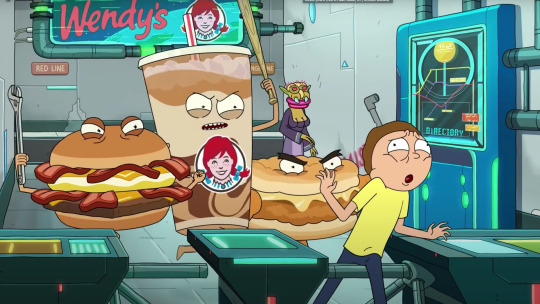
Wendy’s X Rick and Morty Collab
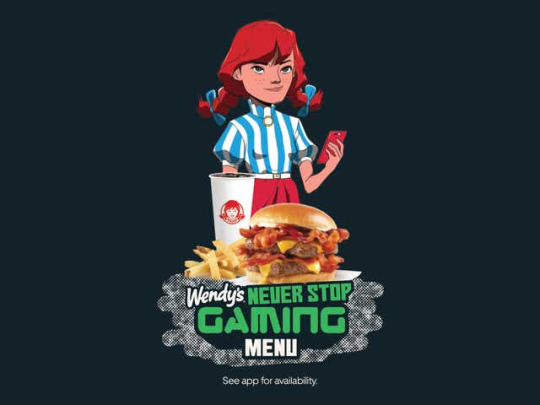
Wendy’s Never Stop Gaming Collab with Twitch streamers – TFUE, FLIGHT, itsHafu, xChocoBars and Myth
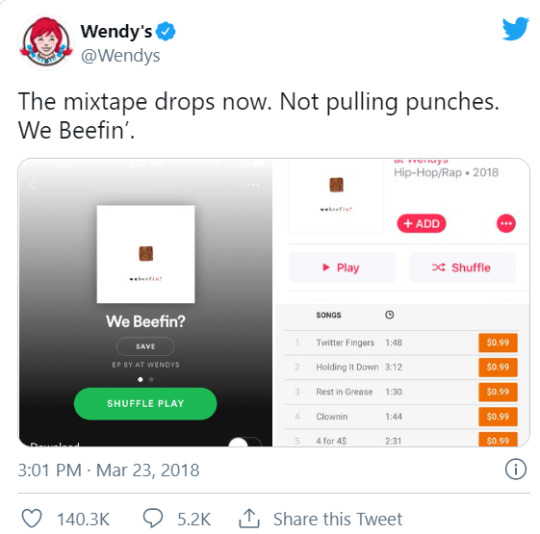
Wendy’s attempt at relatable Twitter content
We moved on to look at transmedia marketing techniques. At it’s essence, transmedia marketing is about connecting a product/brand with the consumer. We are living in a “converged culture” wherein users are taking advantage of a range of channels in order to engage with content. Transmedia marketing is the form of transmedia I’m most familiar with, having prototyped marketing campaigns across a range of platforms including social media, video advertisement, sales platforms and physical print. This element of transmedia is what springs to mind first, so it has been interesting to look at how a narrative can be told in this way.
Moving on now we looked at creating a trans media “story world”, which is all about the world you’ve created in which your story occurs. The characters, location, theme etc. It’s important to keep in mind when creating a story world that each individual component exists with a purpose, what it means to the story and how it interacts with other components. We looked at an image of a pond ecosystem to demonstrate how a story world needs to work in the same way, with each individual feature serving its purpose in the story. Speaking from acquaintance with an “experienced screenwriter” in his 2007 book, Convergence Culture: Where Old and New Media Collide, Henry Jenkins states “When I first started, you would pitch a story because without a good story, you didn’t really have a film. Later, once sequels started to take off, you pitched a character because a good character could support multiple stories. And now, you pitch a world because a world can support multiple characters and multiple stories across multiple media.” Thinking about this in the context of transmedia, being able to produce multiple elements to a story world across multiple different platforms is an incredibly profitable tactic, allowing businesses to sell a wider range of media.
Class Task: For our initial smaller class task we were asked to “map out” a transmedia story world, using an existing story and developing it to work across multiple platforms. My group decided to work on a modern take of the classic Robin Hood story. We briefly discussed the changes we were going to apply to the story and started writing down different potential media avenues, although i think it would've been much more beneficial to have used something like Lucid Chart to help us map it all out visually.
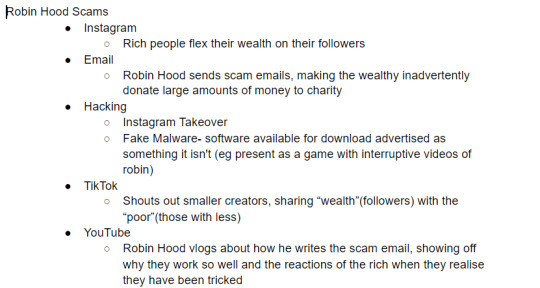
Our take basically surrounded the idea of taking from the rich and giving to the poor, but wanting to take a modern spin on things. We wanted Robin to be an online hero, scamming and hacking the rich and redistributing the wealth. We also played with the idea of this “wealth” being something other than money: followers and views. I liked this idea particularly because i thought it would be interesting to have a campaign that only existed online using this “currency” that otherwise has no real-world value. We discussed how on his rise to notoriety Robin Hood could be redirecting the general public to smaller creators; stealing clicks and views from the “rich” and giving it to the “poor”.
Task 6: For our final class task we were asked to prototype some content for the aforementioned story world we had invented. We all discussed what we were going to make and went off individually to do it. I think it would’ve been good to think about prototyping online platforms in more detail, perhaps thinking about setting up social media for Robin or even spoofing some “instagram takeover” stuff. For example, i think the idea of an instagram takeover would be a heavily audience interaction based medium, whereas the pieces we drafted were less interactive and in my opinion would’ve been less effective in terms of user engagement. I drafted up a downloadable game where every now and then little glitches and pixelation occurs making the audience believe there may be something wrong with their computer or the game. After a while, the game continually “crashes” with video of Robin Hood interrupting to let the player know they’ve been “hacked”. Taking this idea further, it would be interesting to think more about the actual gameplay. I was considering an idea where perhaps the choices the player makes influences the outcome, thinking about making this a piece of media itself as opposed to some kind of promotional material for something bigger which is how i’d envisioned it previously.
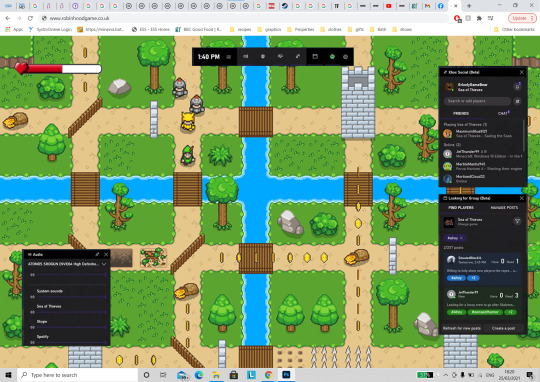
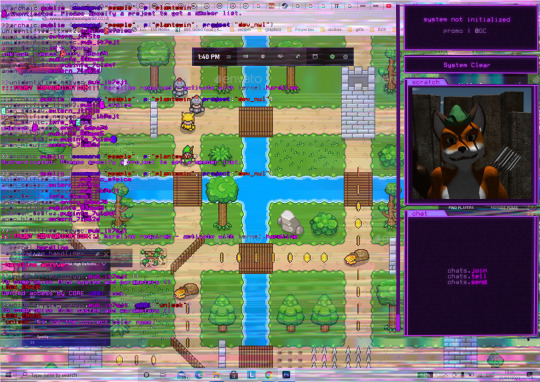
2 notes
·
View notes
Note
Hiya! I'm a new writer, aside from an odd bit of fanfiction here and there. I'd like to finally begin an original story. What are your initial actions when beginning a new work? Aside from that, do you have any more tips for me to adhere to? I'm not looking to publish or anything, this is purely for fun.
Guide: Starting a New (Long Fiction) Story
Whether you’re writing for practice, publication, or fun, the process for writing a new original story is different for everyone and often depends on the project itself. Here are some things to consider as you start to prepare and get started on your new story.
1. To plot or not to plot?
The first thing you’ll want to do is decide how much you want to plot out the story before you start writing. Some writers are avid plotters, planning out every detail of their story before they begin. Other writers prefer to take an idea and wing it, and some people plot as they go. At the very least, it’s a good idea to make sure you know the following before you start writing:
Who is your protagonist? What do they want, why do they want it, and how are they going to get it?
When and where is the story set? What parts of this setting will play the biggest role in the story and how?
Who or what is the antagonistic force? Every protagonist needs an antagonist to work against them, creating obstacles they must overcome as they try to reach their goal. An antagonistic force is anyone or anything that creates those obstacles, whether a super villain, overbearing but well-meaning parents, a disease, a natural disaster, or a plague of zombies.
Know your beginning, middle, and end. Before you start writing, it’s a good idea to have a mental picture of how the story starts (your character’s normal life before everything turns upside down), what’s happening at the midpoint (what happens to raise the stakes and give the protagonist a big push toward the “final showdown” with the antagonist), and how the story ends (does your character defeat/survive the antagonistic force? Do they reach their goal? How does your character or their world change as a result?)
2. Research and Inspiration...
Whether or not you decide to plot, you will probably want to spend a little time doing some research and looking for information. If you are choosing to plot, you may want to do this afterward or during your plotting phase. Ultimately, you’ll want to consider whether there are any elements in your story that you need to know more about before writing them. This might include things like learning what it’s like to be deaf, how castles are laid out, or what kinds of plants and flowers typically grow in forests. If you’re setting your story in a real place, or are using a real place as inspiration, you may want to learn more about that place. If your story takes place in a particular era or involves a particular event or type of event, you will want to research those. For inspiration, you may want to look for pictures of everything from characters and clothing to buildings and places. Some writers enjoy putting together pinterest or tumblr galleries to house inspiring pictures. You may also want to put together character, setting, and story aesthetics (collages), put together a writing playlist that has the right feel for your story, or even travel to places or do activities that are related to your story.
3. Planning, preparation, and organization.
If you’re going to wing it, you’re pretty much ready to get started with writing now. However, if you’re going to plot your story, this is the point where you might want to do a little more planning and preparation before you start writing, and depending on how much stuff you accumulate through these early stages, you’ll probably want to do a little organization, too.
When I start a new story, I always do three things:
-- purchase a three-ring binder and dividers for keeping track of my story plans-- set up a story specific folder on my desktop with necessary subfolders-- set up a story specific folder in my browser with necessary subfolders
I like to decorate my binder with a printed out aesthetic picture and a pretty title on the side. The divider tabs for my binders usually contain sections like: characters, setting, outline/scene list, notes, rough draft, etc. If there is more than one major setting, sometimes I’ll give each setting their own divider. It really just depends on the needs of my story, and sometimes I re-organize my dividers as the story progresses and my needs evolve.
My desktop folder usually contains the following subfolders: drafts, storage, notes-ideas, character stuff, setting stuff, inspiration, and then sometimes I do additional subfolders... like my “character stuff” subfolder might have subfolders for each character or characters in each specific setting.
My browser folder is usually kind of a mess. I will sometimes do subject-specfic subfolders, but usually I just bookmark whatever I need to and make sure the bookmarks I access the most are at the top of the list.
Again, you will probably add to all of this as you actually get into the plotting phase. I consider this phase and the plotting phase to go hand-in-hand. This is really just about getting everything set up and ready to go.
This is also a good time to figure out things like a writing schedule (if you need to set one), daily or weekly word count goals, and get your writing space organized if you have one.
4. Plotting...
There are many different ways you can plot your story, all depending on what works best for you and the needs of your story. Some writers simply like to come up with an exhaustive summary of events from beginning to end. Others like to do some sort of outline. You may want to do a timeline and a scene list as well. My post how to outline a plot will walk you through some of the different options, and my plot and structure master list has lots of other posts that may be useful to you during this time.
5. Start writing!
Once you’ve gotten your story plotted out (or not, if you’re choosing not to plot), it’s time to sit down and start writing. Here are some things to keep in mind:
-- This is the very first draft of your story and it’s going to be ROUGH, which is why it’s often referred to as the “rough draft” or “zero draft.” This draft isn’t going to be perfect. It’s going to be messy, ugly, meandering, and kind of awful, and THAT’S FINE!!! This is just the rough sketch or mockup. You’re going to improve upon it later.
-- Because this is the first draft, now is not the time to worry about word choice, sentence structure, word play, grammar and punctuation, flawless story structure, etc. Just get the story down to the best of your ability. You’re going to make it pretty in the later drafts.
-- Also, because this is the first draft, don’t be afraid to go a little hog wild. You don’t have to worry about word count and having a tight story now. Feel free to go off on tangents, delve into fluffy scenes, and follow weird threads. Dive in and explore your world and its characters. This exploratory process allows you to kind of throw everything at the wall and see what sticks. A lot of the time you’ll end up discovering gems you hadn’t considered initially. Again, you can figure out what to cut out later on.
-- AGAIN... DO NOT EDIT AS YOU GO. I mean, look... sometimes, more experienced writers develop a process where they do edit as they go, and that’s fine. But until you’ve written enough stories from beginning to end to know what works for you, don’t trouble yourself with editing as you go. The most important thing right now is to write this story from beginning to end. Once you get to the end, you can go back and make it pretty.
-- It’s okay to feel frustrated and have days where you need to take a break. You may have days where you just want to delete the story and move on, but don’t do that. If you need to, walk away from it for a few days or a week and come back to it later. If the story still isn’t working for you, save everything and start on a new project, but never delete what you have no matter how much you feel like you hate it now. You never know when inspiration will strike and you’ll decide to go back to an old project.
Good luck with your story!
411 notes
·
View notes
Text
The Future of Star Butterfly... or The End?

The end of @disneyanimation‘s/@disneyxd‘s finest franchise yet, @daronnefcy‘s Star vs. the Forces of Evil, is a time of great lamentation for me, as I love Star Butterfly to an insane extent (and thus the respective franchise).
I love Season 3 more than Season 4 (and in Season 3 is the most important reason why I love Star), but the show’s been little different since Season 2. The show changed very much after Season 1 (my favorite season) in character design, animation and the storyboard artists involved. SvTFOE is a really great show, but I personally see room for improvement, if Disney chooses to produce any future content, whatever media that is. Before we act on petitions for new content (try not to push Disney Television Animation too hard on this. It’s up to them, NOT Daron Nefcy, and Disney’s probably really busy with other shows at the moment), let’s consider some aspects of the show...
First, I note some specific things that I dislike about SvTFOE in general.
Mostly “Traditional” Animation: What happened to the animation? The animation started out in Season 1 (and the pilot) as what I call “model-rigged” animation (some call it “flash”), animated by @littledigits at Mercury Filmworks (The Powerpuff Girls Movie, Mickey Mouse, Wander Over Yonder). The visual approach appeared to be very cartoon-y, like WOY, and the attention to detail in not only character design but also the effects design, multi-layered background panning and camera de-focusing was present only in 13 individual (11-minute) season 1 episodes, and also in the 2017 “Interdimensional Scavenger Hunt”. Such things of those episodes are not in later episodes as they are only traditionally animated. Toon City’s animation seemed slow-paced and a little jerky to convey quick movements at times, which didn’t feel like that of Mercury. Now, I came to love model-rigged animation because of SvTFOE, but generally I prefer traditional animation, which is fairly fitting for the more dramatic, intense episodes of the series. The first Toon City episode, “Mewberty”, had a number of design/animation mistakes (i.e. the shots of the “My turn” moment). Of the 2 animation companies that were involved, Rough Draft Korea (which also worked on the Season 1 episode “Blood Moon Ball”) and Sugarcube, though Rough Draft does animation for some of the best in American animation, yet I prefer the visual approach of Sugarcube as the designs are much cleaner and look a little more on-model. The lines in Rough Draft episodes aren’t as smooth and the models kind of look more different (perhaps off-model) per shot and/or movement, but the animation Rough Draft did on Samurai Jack EPISODE XCVIII, namely Ashi’s fight scene, looks amazing. rwinger24 pointed some important elements lacking in the 2016-2019 episodes out: “Absent from the Mercury and Toon City animation (are) these animation principles- Anticipation- Follow through and overlapping action- Slow in and slow out (the Rough Draft Korea episodes miss this principle as the animation appears jarring/unnatural)- Secondary action(And notable absence of motion smears)... (and, like) 80s /90s cartoons sometimes (the picture bobbing/weaving from the telecine transfer, and not the constant use of 24 drawings like SVTFOE does (mostly from Rough Draft Korea).
Different, Less-Detailed Character Design?: The character design never looked more graphic and detailed than in Season 1, done by @cheyennecurtisart and @lynnvwang as well as @cunch. This’s particularly noticeable in the Mercury Filmworks episodes. The designs in the Toon City episodes aren’t as smooth and, the way the episodes are, not necessarily as exaggerated in cartoon-y fashion as the Mercury Filmworks episodes. The change in character design, which I noticed, is so drastic, that my follower rwinger24 suggested that I should make a post about the changes. As for the rest of the series, @aniramiart became the main designer along with @beckyandfrank / @tinykittenteeth. They do some good designs, given what Star endured or how she reacted at certain times, but most of them aren’t as detailed as Cheyenne’s. What I dislike most about this design change is that, regarding mostly Stephanie Ramirez’s designs (plus storyboard artists and Rough Draft’s animation), the character design of at least Star begins to resemble Gravity Falls a bit much, which detracts from the unique designs of SvTFOE in its first Season. Relatively, one of young Star’s designs in “Marco Grows a Beard” (Tyler Chen’s first episode) also resembled the character design of Gravity Falls, but that was still Cheyenne & Lynn Wang on the episode. On the other hand, the Season 2-4 designs look more on-model and smoother in the Sugarcube episodes. Otherwise, in potentially cartoon-y designs, it just doesn’t stretch as far as those of Season 1/Mercury episodes, though that wouldn’t exactly be fitting for the more dramatic episodes. The designs, of course, depend somewhat on storyboards. Perhaps the wackiest storyboards are by Ian Wasseluk (who rwinger24 references in the cartoon-y looking approach on the series), as well as Dave Stone (from Teen Titans GO!) on “Match Maker”.
Quiet (and typical) Sound Design: Throughout the show, the sound design’s style was very quiet. It’s more foley than SFX. The sound effects designed by both music score composer @brianwithanh and Advantage Audio’s Robert Poole (Season 1) and Heather Olsen (Seasons 2-4) are unique to the series and absolutely nothing I criticize. What I dislike of the sound design is that, given the very cartoon-y visuals (particularly Seasons 1-2), the sound design is more realistic than cartoon-y (save for very rare cases like the opening scene to Bon Bon the Birthday Clown, which was very deliberate as I imagine). Usually, Advantage seems to sound either too cartoon-y (i.e. The Fairly OddParents) or too quiet. In the case of more dramatic episodes, the cartoon-y sound shouldn’t be pushed. If Jesse Aruda, Roy Braverman, and/or Rich Danhakl did the sound design (Danhakl did the sound design of The Tom and Jerry Show at Advantage and edited sound on “Mathmagic” & “The Bounce Lounge”), their array of cartoon sounds would be better than the usual, very specific designs of Michael Warner, Robert Duran, Poole II and Olsen. The other main critique I give is that, like most sound services, the action-y sound effects (explosions, crashes, etc.) depend more on typical Hollywood Edge/Sound Ideas (that is “stock” sound effects) than the unique sounds of Joel Valentine and Skywalker Sound; there’re also the common, if applicable, use of “Cats Two Angry Yowls”, “Medium Exterior” Crowds and other cliche vocal recordings that are overused, particularly by Advantage Audio. Recording walla as well as other animals (or at least using lesser-used animal and crowd vocals) would be an improvement. Even the horse sounds used (rarely using one from the Sound Ideas Lucasfilm Sound Library) are mostly the typical, pitched-up if necessary. Compare that to an entire SFX library of horse sounds that Skywalker’s Nia Hansen (sound design assistant of Big Hero 6′s movie but not the show) recorded just for War Horse--and she was credited as only an apprentice [sound] editor!
“Controversial” Content: The last thing I dislike, from more or less a Christian point-of-view, is that there are a few episodes that have material and/or images that I, for one, among many, would view as “controversial” or “polarizing”. I’m a little suspicious of some situations that may regard controversial subjects in a few other episodes as well, though no dialogue explicitly states such things. I can not say what that material is or what episodes have it, but I mean the best in concern for the sake of the series’ reputation. The least that we can do (and I certainly do), in all situations, is to pray for the salvation and sake of Daron Nefcy and her amazing team.
(BRIEF SPOILER!) Second, before we can give influence to anyone to contribute to the Star vs. the Forces of Evil franchise, we need an answer to this very important question:
Is this really the end of Star vs. the Forces of Evil?: It was always on my mind as to whether or not “Cleaved!” was more than the end of the main story linked throughout Seasons 1-4 (though the last villain, in Season 4, is Mina, from Season 2). Does Disney claim that it’s the series finale because they had to move on to other projects, or is the story of Star Butterfly, the Underestimated, at the true end that Daron Nefcy wanted? Think about Wander Over Yonder: it was cancelled after season 2, but, although that season wrapped up a story throughout that season (and began at the very end of Season 1), still there are more stories that could be told... if Disney wanted to produced new WOY content, with or without Craig McCracken. Also, (spoiler) Star is not gone; worlds collided, and there can be more adventures for the franchise (perhaps Hope Hadley or Charlie Booth/“Gustav” could get a spin-off?). Whatever more we want of SvTFOE or WOY, we must speak to Disney Television Animation about this and let them to know, NOT the show creators. Don’t ask Daron Nefcy about new SvTFOE content in the future; ask Disney TVA about that.
Third, in response to what I personally dislike about major changes in the series since SvTFOE Season 2, and as a devote fan of Star Butterfly / Star vs. the Forces of Evil, I wish to propose, to all of those at Disney Television Animation, suggestions of creatives who deserve to contribute their amazing talent to the future content of Disney’s most beautiful franchise yet.
Who should run the show?: As far as I know, creator Daron Nefcy suggested that she left Disney after SvTFOE (“I’ve been slowly cleaning out my office (I know, sad!)”) to do a voice on Nico Colaleo’s Ollie and Scoops, so, if Disney intends to produce any new content, then it may happen with Daron out. Who would I suggest to help run the show? Dave Wasson, Season 1 Co-Executive Producer/Supervising Director, could return. I strongly believe that Lynne Naylor-Reccardi (Samurai Jack, The Ren & Stimpy Show, The Shnookums and Meat Funny Cartoon Show) would be a very good choice in running the show, in addition to storyboarding, writing, directing, character design, and/or art direction; she produced Hercules and Xena: The Battle for Mount Olympus and was a major part of that film. Then, of course, for the sake of detail and action, Genndy Tartakovsky would be a great choice; he’s currently with Sony on a few projects and CN for Primal, so at least people from his team, like Paul Rudish of Mickey Mouse and Bryan Andrews and/or Mark Andrews of Sym-Bionic Titan, would be really good for directing. I certainly trust how good they are at both action and heart, on shows like Samurai Jack. As for really wacky, cartoon-y styles, I also would recommend Kyle A. Carrozza, @tvskyle from CN’s Mighty Magiswords, who is currently at Warner Bros. on Animaniacs, and Bob Camp from The Ren & Stimpy Show (also a storyboard artist for Sym-Bionic Titan and Suburban Daredevil), to contribute directing/producing and storyboarding. I would recommend @crackmccraigen, who "wanted to make Star when back when @daronnefcy pitched it to us at The Cartoonstitute. CN said no though.” However, so far, Craig left Disney; he currently produces Kid Cosmic for Netflix.
Who should write and storyboard the stories?: First, I suggest Tim Hodge (@baldmelon, The Tom and Jerry Show, Jonah: A VeggieTales Movie, Aladdin, Mulan), who also worked for Disney, as well as @gadworks, @kalikazoo, @mikepelensky, Darrick Bachman (Samurai Jack, Mickey Mouse) and Richard D. Pursel (Tom and Jerry Tales, Mighty Magiswords, The Ren & Stimpy Show). For more action-y sequences, I’d look to Genndy Tartakovsky, Bryan Andrews and/or Paul Rudish; they sure know their action stuff. Lastly, I note Charlie Bean, David Krentz, Kyle A. Carrozza, Lynne Naylor-Reccardi, Will Finn, Stephen DeStefano, Jeremy Polgar (Samurai Jack Season 5, Teen Titans Go!) and Bob Camp, among others. Former writers/storyboarders Mike Mullen, @ianwasseluk, Scott O’Brien, Kyle Neswald, Kat Ketchum, @brettvaron, @giancarlovolpe and Dave Stone should return. A newer storyboard artist for Spongebob, April “Pinkie” Davis, has some humorous potential too and I’d highly recommend her. Josh “Zeurel” Palmer and @akron-squirrel are also very talented artists/animators who deserve a show.
Who should contribute visual design?: Luckily, Cheyenne Curtis returned for a few episodes after Season 2; she currently works at Nickelodeon but might like to help on the designs. In point of fact, she should be “Lead Character Design”. I’m not sure if it was Cheyenne or Lynn Wang who did the really graphic character designs (Match Maker, Brittney’s Party, The Other Exchange Student, etc.), though hopefully Lynn Wang could occasionally contribute to future SvTFOE content, with or without Cheyenne. Among the 2 (and perhaps Jennifer Goldberg as well), the new character designers I’d suggest to contribute would include Jeremiah Alcorn (@alcornstudios, Teen Titans Go!, Wander Over Yonder), Lynne Naylor-Reccardi (The Ren & Stimpy Show, Samurai Jack), Carey Yost (The Powerpuff Girls, The Ren & Stimpy Show), and April “Pinkie” Davis (Spongebob Squarepants). I’d also recommend Bryan Arnett (Wander Over Yonder, The Mighty B!), Adam Rosette (who did designs for the original test pilot or something in 2014, according to the IMDb), Craig Kellman (The Powerpuff Girls Movie, Dexter’s Laboratory), and Kyle A. Carrozza and Lindsay Smith-Carrozza (Mighty Magiswords), among others. As for the location design, it changed little, but I’d still refer to The Parpan Brothers, Season 1 art directors @joshparpan & @justinparpan (currently art directors at CN for @victorandvalentino) and perhaps their assistant Jason Stebbings. David A. Dunnet and Larry Murphy are very good cartoon location designers. Certainly, Stephen DeStefano (@stephendestefano, Samurai Jack, Mickey Mouse, The Ren & Stimpy Show) would serve as a swiss army knife of visual design in storyboards, character design and location design! I’m not concerned about most of the prop designs either, though Dustin d’Arnault is a rising talent in cartoon props/effects design, like Chris Battle. I’m not too concerned about effects design, referring to the original one, Tony Unser, and the last one, Eric Gonzalez, but contributions from Dustin d’Arnault and the amazing MIchel Gagne would do wonders for the show. As for newer, fresher talent, @akron-squirrel, Josh “Zeurel” Palmer and Scott Forester are some excellent choices for new creatives visual development.
Should the show/new content onward be in a “Scope” aspect ratio, like 2.40:1? Star Wars: The Clone Wars, Tigtone and Genndy Tartakovsky’s Primal are in a “letterbox” widescreen format, and it’d look more cinematic to do the shots in a director-envisioned “CinemaScope” format.
Who should direct the animation?: The main timing supervisor Shaun Cashman was a part of The Powerpuff Girls and Sym-Bionic Titan, so that’s good for the *traditional* animation (not to mention timing director Patrick Gleeson, who animated the works of Don Bluth), but personally timing/animation directors and supervisors should include Genndy Tartakovsky, Tony Fucile (perhaps a stretch, but he’s really good), and Robert Alvarez. Rough Draft’s designs should look a little smoother IMO, though I generally prefer Rough Draft over Sugarcube. Of course, for the more comedic SvTFOE content in the future (but not limited to cartoon-y scenes), I want Megan Ferguson to return, preferably with Mercury Filmworks. Mercury could at least help animate background layouts and visual effects for the traditionally animated episodes. Still, I learned from Final Space and namely the Rapunzel’s Tangled Adventure episode “Cassandra’s Revenge” that “puppeted” animation can work very well in more serious, cinematic scenes that aren’t as “cartoonish”. Additional animation contributions from Gabe del Valle and Josh “Zeurel” Palmer would be good to reference too.
Who should contribute sound design?: First and foremost, if I had to pick one and only one sound designer, I’d look to Joel Valentine, a private contractor who generally did cartoon sound for only Cartoon Network Studios until Craig McCracken got him to contribute to Wander Over Yonder Season 2, perhaps leading Joel to work currently on Disney’s Big City Greens (still also on Genndy Tartakovsky’s Primal). He does both cartoon and action sound on a very unique level, and he proved to be very realistic with vocal sfx (babies, crowds, animals) in Samurai Jack Season 5, making very scarce use of Hollywood Edge SFX. I also really like that castanet sound he uses for characters shaking for any reason. With or without Joel, my devote follower @rwinger24 prefers Spongebob sound designer Jeff Hutchins to contribute; Jeff has a hilarious sense of cartoon sound design, and not only did he learn from Joel, but he also received from Joel The Producer’s Sound Effects Library AND Joel’s ADAP library, with which Jeff could replicate the unique sound styles of Joel, like he did before. Jeff also tends to work at Hacienda Post, where founder and supervisor Timothy J. Borquez could contribute and consult sound design just as his team did at Horta Editorial on The Ren & Stimpy Show, which also has its own stylized array of SFX--and this would work very well for a show with design and animation as detailed in comedic fashion as Ren & Stimpy (think “Brittney’s Party”). It was rumored on IMDb that Warner Bros. Sound (division Audio Circus) worked on SvTFOE; Jeff worked there too, and I guess that they could contribute. Then, of course, the show deserves contributions from Skywalker Sound, namely designers like Tom Myers, Steve Boeddeker, David Acord, Frank Eulner and Al Nelson, as well as Chris Scarabosio, Kyrsten Mate and Nia Hansen; Matthew Wood & David Acord are also a good team in voices (I’d even go so far as to suggest Ben Burtt to contribute). With Skywalker, there’d be better selections for action sfx (like explosions or ricochets) and other SFX in general, plus more realistic vocal sfx and walla. I also like the works of Robert Hargreaves (DigiPost.TV) and Glenn Oyabe. Among Joel, Hacienda and Skywalker, still, I intend not to cut Advantage Audio out; the series’ sfx and Brian H. Kim’s sounds are probably there, as are the series’ foley artist John Lampinen, but I would want Jesse Aruda and Rich Danhakl to be in place of Poole II or Olsen. (as of September 10th, 2019 A.D., Danhakl replied to me in an e-mail, “Count me in for the toonie Star spinoff (I’ll pass the message along to Jesse [Aruda] and Roy [Braverman])!”) A main proposition to approach the series’ sound as a whole, as Ben Burtt suggested in an article, is this: “You don’t achieve the final cut of your movie the first time that you cut it. [(Picture) Editing is] too big of a job. You assemble the first cut based upon all of your best available knowledge. You’re finding your way through the story. You’re checking notes, a script, and seeing what the material might dictate. Then you build each successive cut, and you see what’s wrong and what’s right. It takes time and a series of developmental steps. No director want to rush through it. The same process should hold true for sound design. There needs to be a development phase where you have the same type of time to experiment, fail, and nurture the sound design to full bloom in all its beauty.” Speaking of Ben Burtt, he might as well contribute since it seems that he does little sound design for projects these days. Previously I made a post about the important emphasis of the series’ sound design.
I pray every day of my life that Star vs. the Forces of Evil as a franchise of Disney will be blessed with creative talents who I really admire, and I hope for the best. Speaking of Hope, I find supportive/background character Hope Hadley, created by character designer Cheyenne Curtis, to be an interesting and attractive character, so I wonder if Cheyenne (who works at Disney) and Disney (who owns the rights to Hope) would create something out of her, as I said before--and Cheyenne thinks about this possibility: “If I ever get a cartoon show it’s my goal to have multiple episodes throughout the season with rain.” Either way, my devote follower @rwinger24 would agree with some of my choices (particularly of sound and Jeff Hutchins).
If you’re a devote SvTFOE fan and you agree with any of these decisions, then SHARE THE POST! Let Disney know, and see what Daron Nefcy also thinks of this too (even if she can not return). I also encourage you to share IMDb lists of Creatives for Future SvTFOE Content and the same for Cheyenne Curtis’s cartoon show and/or this Tumblr post summarizing names of those to join and return on SvTFOE, so that we--and the amazing creatives whom we admire--can be a part of the unique franchise of SvTFOE! I love Star Butterfly enough to want to spark an influence, however we can.
Besides that, Samurai Jack seemed to end after Season 4, but it returned after 12 years, 5 months and 14 days with Season 5. God knows what new content/media Disney could produce (with or without Daron Nefcy) in the future!
Tweet version here. Share that too!
Finally, forget not to share also this complimentary post listing some of the most important creatives for Disney TVA to recruit for new SvTFOE content!
I thank you for sharing, noticing and/or reading the post.
If you wonder why I love Star much, see this post (spoiler if you saw not Season 3 yet)
BTW, if you like The Powerpuff Girls and/or relative team members, check this post out too (and share it if you agree)!
#star vs. the forces of evil#star vs the forces of evil#walt disney television animation#disney television animation#disney animation#daron nefcy#cheyenne curtis#megan ferguson#mercury filmworks#dave wasson#genndy tartakovsky#bob camp#kyle a. carrozza#lynne naylor#lynne naylor-reccardi#gabe del valle#jeremiah alcorn#lynn v. wang#lynn wang#animation#art direction#josh parpan#justin parpan#joshua parpan#future media#future content#new content#disney#skywalker sound#savesvtfoe
15 notes
·
View notes
Text
emotionally colorblind: plance in season 8
(part one of three)
In the series finale of The I.T. Crowd, one of the techs has started dating a girl from another department. (Yes, this is VLD meta, just stick with me.) He feels the relationship is going well and is very happy, and brags to his coworkers that his girlfriend recently told him he was “emotionally artistic” - which he interprets to mean he’s on the “artistic” emotional spectrum because he’s so in touch with her wants and needs. (At this point, it’s become clear to the viewer that his girlfriend has actually accused him of being “emotionally autistic” and believes him to be on the autistic spectrum.)
Later that day, his girlfriend calls again to tearfully ask if he’d accompany her to her grandfather’s funeral and abruptly hangs up on him when he cheerfully agrees. He’s baffled by her reaction until his manager rightly points out that his girlfriend was upset because the way he responded was completely off base from the subject matter, as his chipper tone of voice made him sound as if he’d just been invited to a music festival rather than having any sympathy for his girlfriend’s loss. Only then does it occur to him that his response was inappropriate because funerals are sad.
“‘Emotionally artistic’? You’re emotionally colorblind,” his manager mutters in disbelief.
Old news, but Season 8 isn’t what anyone expected
‘Emotionally colorblind’ - e.g., giving inappropriate responses to a topic because of an inability to perceive the nuances of a situation - feels like a pretty good description of Season 8, in which excellent animation is overwhelmed by moments in which characterization feels off, dialogue doesn’t seem to fit, or the plot clashes with what’s actually being shown on screen. Those moments - along with the conspicuous lack of reaction from the cast and EPs in the month since its release and cryptic criticism from crew members - have led many fans to conclude that the version of Season 8 released took the cast/crew by surprise. Posts by Aria C., a former DW intern while Season 8 was in production, suggest that the overall plot hadn’t changed dramatically since the scripts were being drafted, but that doesn’t mean that individual character arcs weren’t subtly adjusted along the way.
While it’s not clear exactly how much actually changed about Season 8 during production, we do know that many of the changes were made at the last minute. The most noticeable changes seem to have been in response to the backlash against how LGBT characters were portrayed, although this article covers many of the other pacing issues in Season 8 while some of the discrepancies between the audio description and what’s actually seen on screen are listed here. The single biggest last-minute change seems to be the epilogue (including the final few stills) which was approved extremely late in the production process and underwent additional changes after being leaked just weeks before the season’s release.
I strongly suspect that Pidge and Lance had an arc in Season 8 that was another casualty of the last-minute changes.
The End is the Beginning
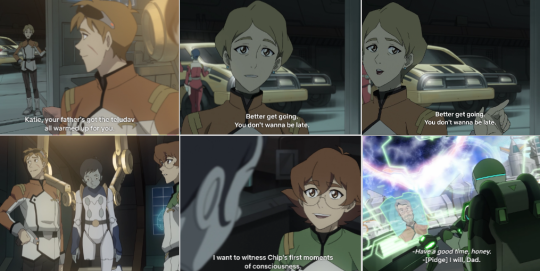
Let’s take a look at the ending of the series’ final episode. One year after the final battle with Honerva, Pidge and Matt are working on building a humanoid robot that Pidge dubs Chip. Colleen interrupts to tell Pidge she should be heading out; Pidge looks serious and doesn’t respond, then recovers a moment later and makes Matt promise to wait for her to get back to finish. She leaves her glasses with Chip before heading off in the Green Lion, as Sam and Colleen both watch her leave.
Colleen: “Your father’s got the teludav all warmed up for you. Better get going, you don’t want to be late.”
Sam: (cheerful) “Have a good time, honey!” Pidge: (laughingly) “I will, Dad.”
The way they’re talking to her is the way parents would talk to a teenager who’s about to go to a party or on a date, peppy and almost teasing. Pidge’s serious expression suggests that wherever she’s going is somewhere she’s not entirely ready to be - she isn’t upset about needing to be somewhere, but she isn’t rushing out the door to get there, either. Maybe she’s nervous - we can’t tell.

We cut to Coran and Merla on Altea as they discuss preparations for “the first Celebration of Allura”, then over to Lance as he recounts the story of Allura’s sacrifice to a group of schoolchildren sitting by her statue, telling them that while he misses her, he knows she’s still with all of them. The Altean teacher, in a chipper tone similar to Pidge’s parents, informs the kids that “Paladin Lance has somewhere to be in a few doboshes.” Just then, a wormhole opens and Lance looks up as the Green Lion flies through. He turns away from the statue to watch Pidge land, a smile on his face.

The scene fades to the Paladins having dinner by the statue of Allura. Within moments, it’s obvious that their reunion is the feast Coran and Merla had been discussing earlier. The Celebration of Allura is the one year anniversary of her death. The paladins’ reunion is a memorial.
We’ve seen memorials in VLD before. In Season 7, Shiro visits the Garrison’s memorial wall for those KIA. Later, Earth has a giant memorial service for the victims of just one battle, as Shiro addresses the crowd: “There isn’t one of us here today who hasn’t experienced the tragedy of losing someone close. It truly feels like a light has gone out in our lives and the sun itself couldn’t reignite it. But that light, that fire, hasn’t gone out completely. It’s fueled within each of us by the memories and the love of those we’ve lost. …”

After the one year timeskip, we see Keith persuading the Galra to join the Galactic Coalition with Shiro and Hunk leading diplomatic negotiations on the Atlas; all three invoke Allura’s example as they work towards peace. Hunk even mentions the significance of that day being when they commemorate Allura’s sacrifice. What she did and why she did it aren’t secret. It stands to reason that the anniversary of her death - the anniversary of when Allura saved their reality and countless others - wouldn’t be a ‘celebration’ only for six people. Everyone, everywhere, should be taking a moment to remember her - especially those who fought at her side, like the Holts.
Instead, Sam and Colleen’s reactions in Pidge’s scene are jarring. While things may be different in Voltron’s future world, I doubt any parent would tell their child “Have a good time, honey!” as they go to a memorial dinner for their dead friend. Because as The I.T. Crowd pointed out, funerals are sad - and so is any reminder of someone’s death. You don’t have to be constantly moping and sobbing because you miss someone, you can still celebrate their life, but that kind of event still has a somber, bittersweet element to it. Telling someone ‘Have fun, don’t be late!’ as they head off to a memorial would definitely qualify as emotionally colorblind. It’s hard to believe the actors and voice director would have agreed to record the scene within the context we got onscreen.

Lance’s scene makes it even more complicated. Showing Lance turn to watch only Pidge land is a bizarre choice if the purpose of his scene is to emphasize how much Lance still cares for Allura before showing the other Paladins arriving on Altea. It only makes sense for Lance to turn away from looking at Allura’s statue and towards Pidge if Pidge and Lance are supposed to have a deeper connection.
If the focus is actually meant to be on Allura and this event - and on her family coming together to remember her - it would have made sense for Lance to look past Allura’s statue to see the Blue Lion in the distance, Red parked next to it, as Green, Yellow, and Black emerge from the wormhole to land beside them. If the animation had to be rushed for a last-minute change or the budget was stretched too far, they could have just used the same shot of the Lions sitting together at the end of dinner with daytime lighting instead of night, fading into dinner instead of fading out.

Pidge and Lance’s scenes would also have benefited from being re-recorded with slightly different dialogue and delivery. For example:
Colleen: (serious, but gentle) “Your father’s got the teludav ready to go. You don’t want to be late, Katie.” Sam: “Tell ’em hello for me.” Pidge: (a little reserved) “I will, Dad.”
Teacher: “I think Paladin Lance has some visitors to go meet, and you all have class…”
VLD’s had to work around making the dialogue fit changes to the animation/plot before. Take The Feud, in which Keith sounds bizarrely calm compared to the others, which the EPs later explained was because Steven Yeun recorded his lines before the storyboards and script had finalized what the paladins’ reactions would be and he was too busy to re-record before the deadline, so they kept his first take. (I suspect that’s also the reason for Keith’s annoyed-sounding “Don’t miss” comment to Lance in Know Your Enemy, which doesn’t mesh with their otherwise more positive relationship at that point, although I have absolutely no proof) But Yeun’s situation isn’t the norm - in cases where the actor was genuinely too busy to re-record, the show either used soundalikes or wrote out a character where possible, replaced dialogue, etc. Any of those tactics could have been valid workarounds…. unless the change was made relatively last-minute and there just wasn’t enough time.
So if the ending is missing the context of an additional scene between Pidge and Lance, what else might have been cut? And why?
I’ll explain in part two.
#sarah forms voltron opinions#plance#flirtyrobot#pidgance#vld s8#voltron critical#plance meta#been on a bit of a hiatus for the holidays#not much time for tumblr meant lots of time for theories#my non-fandom friends watched s8 over the holidays and i got swarmed with questions#which was a little validating because it's one thing for fandom to be nitpicky but if casual viewers are also watching and going 'uhhhh what#was THAT?' then maybe something really is off#i've been thinking a lot about cultural differences while writing this#obviously funerals are the biggest event but the first year usually has a memorial of some kind whether with a religious service or just as#a gathering of family/friends... if it's a family member the first few years usually involve doing something#just because it's hard to be alone#PSA: the i.t. crowd is a good show#long meta is long thank you for reading??
46 notes
·
View notes
Text
Letter of intent

Biotech Express - biotech startup documentation.Alteria - brand management and enforcement.All Your risks and regulatory environment.Climate change mitigation and sustainability.ADT – innovative legal services delivery.Technology, media & telecommunications and privacy.If not, the letter should be written with the same care as the contract-and reviewed by a lawyer, however much he or she may hate the job. Fortunately, in the overwhelming majority of small business transactions, good faith negotiation to a finished contract is very often achievable without letters of intent. But when not, and the LOI is poorly written, that is not likely to be the end of the story. Given this paradox, if the deal goes sour, one party can argue that those agreed-upon points were, in fact, agreed upon-or, in fact, a binding contract and, in some cases, furthermore, that the party relied on the LOI and has monetary damages based on such reliance." The emphasized phrase in the quote (the emphasis is ours) tells the whole story-and further underlines the difficulties: because, in advance, no one can be certain that the deal will not go sour. LOIs are the legal equivalent of 'almost pregnant.' Letters of Intent emphatically state that they are not formal agreements and then often proceed to set forth agreed terms of the proposed transaction. In law, you either have a contract or you don't. As for lawyers, Silver says: "Letters of Intent, legally, are the worst of all worlds. Judith Silver, writing for Intellectual Property Law Server, headlines her story saying: "Letters of Intent: Why Business People Love 'Em and Lawyers Hate 'Em." Business people love them because they help to move negotiations along, provide protections along the way, and occasionally garner positive press and upticks in stock values. Finally, a well-written LOI is of substantial help to those charged with drafting the final contract. LOIs also sometimes produce momentum and clarity and hence speed up a process that both wish to conclude. The LOI may also assure an insecure seller that the buyer is serious-and vice versa. Writing the LOI serves to focus issues and to identify neglected matters. One may also have tactical advantages in having an LOI, especially in cases where multiple buyers are competing for one property. In such situations a letter of intent written at the proper time-before final closing and drafting of actual language-can fix the main issues under discussion in written form and also clearly lay down rules which may be hampering negotiations, such as confidentiality of information. Oral transactions of this type are subject to misinterpretation later, and oral agreements also have contractual force. The process may also take substantial amounts of time. In complex negotiations such as, for instance, the purchase or sale of a business, multiple contracts between buyers and sellers usually take place, many things are discussed, many things are said. Gosfield suggests that "To reduce the risk of litigation, the single most important provision of the letter of intent is to disclaim contractual effect as to all but specifically preserved terms, a key one being the disclaimer itself." The last and fourth type of LOI Gosfield labels "letters of intent that have failed." In fact they are contracts. The third involves letters of intent that clearly spell out elements of the agreement in such a manner "as to permit a competent drafter to complete final documentation without a tremendous amount of additional negotiation." Letters of this type will specify a condition, left to the future, which will make the agreement legal, e.g., approval by a board of directors or signature by a specified officer. The first type openly disclaims any contractual force to the letter, but as Gosfield points out, the letter will have "contractual effect as to the disclaimer." He places letters that deal only with rules for negotiation into the second group and views this type as the best use of LOIs. Gregory Gosfield, writing for the American Bar Association's Business Law Today, suggests that LOIs can be put into four groups arranged from least to most binding.

0 notes
Text
Final Fantasy Games in One Timeline: Some Thoughts
Hi, my name’s Nessa, I have no social life, and I’ve been working on the above theory for going on two years now. I’ve seen some theories on some Final Fantasy games taking place in similar timelines, and a few even being on the same timeline. BUT if you’re interested in an attempt at squashing all of the mainstream games into just one (1) timeline, some handwritten folklore, and too many characters to keep track of, then come on in. These are the bare basics for now, because I haven’t gone in-depth with all of the games yet, and this is the first time I’ve put this theory out there. I openly welcome any critiques and comments you may throw my way!
If you’re interested, here’s what I’ve thrown together:
IN GENERAL:
Though this is one cohesive timeline, I don’t have any exact dates to put on things. Whether it’s one hundred or ten years between games, I believe, depends on how far you’re willing to suspend your disbelief. (I mean, look at our own advances from the 1920s to the 1950s - completely different fashion, atmospheres, and developments.) That being said, this timeline does rely on the fact that the games would be close enough together to have their stories, ideas, and lessons passed on to the next game. How long that takes, though, is up to you.
For everyone following along at home, we’re going to go in this order -
1 / 5 / 3 / 2 / 4 / 9 / 12 / 6 / 15 / 13 / 10 / 7 / 8
Let’s start, then, beginning with:
FINAL FANTASY I (1):
How could we start this timeline with anything else? Of course, this game exists in our timeline here as more of a legend and creation myth than anything real. This is the basis for our world, whether it really happened or not, and in some parts of this world, I like to believe that the unnamed Warriors of Light may have even been worshipped as god-like figures.
V (5)
5 is, at least for me, where this timeline really starts. From what I gathered, 5 has more open space, uninhabited, and quite a bit of monster and nature-made ruin. Only the barest civilization would allow for this. The clothing and atmosphere both stay strictly fantasy, and as a result there isn’t much actual technology in the world yet. The job class system reflects a world relying on people and their natural skills; a place just beginning. Thus, this is where our world starts out.
III (3)
Like 5 before it, 3 holds a lot of the same fantasy elements, but we start experimenting with great technology and use of magic. The world has become a touch less wild, so to speak, and those rural fantasy elements have grown into patches of true civilization here and there. These people have seen evil defeated once before, and they’re stronger because of it.
II (2)
Our fantasy world has developed corruption, folks, and these comfortable palace landscapes now foster a rebellion. We’re starting to armor up our characters with more than just a tunic and a dream, and Firion and his friends have past heroes to look up to and inspire hope from. We see more refined magic use and more airships and metal works in this game. The kingdoms established have had time to prosper, and those in the rebellion have had time to form a secret coalition together against the Emperor. (It should be noted that these first three games I know much less than those to follow, and may be swapped around in later drafts. For now, though, I feel like these fit nicely where they stand currently.)
IV (4)
We’ve hit advanced-fantasy in terms of aesthetic with this one. 4 holds much more tech than its predecessors, and we have boats, ships, and gliders. The crystals worshipped in past games’ lore still remain important to the story. Communication has advanced as well, and we see the first beginnings of other races - most notably, the Lunarians and the Gnomes underground. Those separate civilizations have had time to prosper over the past 3 games, and are now joining the narrative. This game uses advanced magic, and mages and summoners have been able to let their own cities prosper as well. We see more and more kingdoms and larger towns popping up than in previous games, and the world is doing well.
IX (9)
More steampunk technology is entering the picture now. While we remain high-fantasy, airship use has peaked, along with other daily mechanisms. The summoners from the last game are the same civilization that produced Garnet and Eiko, and the Lunarians from 4 are the ones who, upon going to sleep, built Garland to create their vessels - and, therefore, Kuja and Zidane. More animal species are developing in this game, as seen in most cities, and though the kingdoms are much, much larger than in 4, there are still parts of the world left untouched. Something about this fantasy still feels very rustic in comparison to the technology that will come later in this timeline, but most of what 9 presents feels very new in its own world. They have reached their peak development at their present state, and are still producing more and more. Magic use has disappeared from the public and become exclusive to summoners and the mages made by Kuja.
XII (12)
We’ve continued along the steampunk technology route, but we’ve gotten a little more urban now. Kingdoms are crowded enough to show the slums and underground cities that are a part of them now. We continue seeing different animal races in the present day, though they are less common and don’t receive the same rights and privileges as humans do, due to the royalty growing distinctly corrupt. Major magic use is no longer possible, though some simple spells are known exclusively on the battlefield. It’s not impossible to imagine that the royalty may in fact crack down on magicks sellers, in the way that witches were burned at the stake in our own time. Vayne, possibly loosely related to Alexandrian royalty, has the genetic potential to become a summoner, the power lost to most people in this time as the summoners are all but extinct. After the undoubtedly bad rep they gained by Kuja’s destructive magic use, they vanished into the separate world of the summons as a matter of safety. It’s this knowledge that he is so close to doing so and yet cannot that drives him near-mad with want in his drive for power.
VI (6)
High fantasy has now become cyberpunk, everyone. Technology went through the rough since the last game’s plot, and while we still feel very fantasy, we’re also starting to see more of that urban development in the kingdom areas. Magic is used only by the government and military (see: Celes and Terra both have good hands in magic versus the rest of the party), and summoners and their summons exist on the separate plane Terra comes from. Street rats and everyday people are the heroes of this installment, as in the last one, and the not-so-reformed royalty from last game have dipped more into forbidden science and forcibly enslaving soldiers. (That’ll come more into play later.) Vaan and Balthier partner up and initially form The Returners, which develops over time from sky pirate gang to resistance coalition. For one of the first times, we see a villain rise from a regular citizen who gained true god-like powers that the people of this world had never touched before. True destruction is tasted for the first time, but this is quickly remedied when things are set right.
XV (15)
Technology has developed and become more up-to-date here. Royalty still exists, but everything has become more smooth, refined, and modern. Upon Terra’s death, she sent a handful of summons to guard the world in her absence, thus creating the presence of the Six main summons in-game. She would go on to pass her secrets to one select person, an Oracle, who would hand that knowledge down over time and possess the secret to harnessing those summons, should the world ever need it. Hey, corrupt military government, good to see you’re still around, too. (That won’t go away for a while, trust me.) Magic use is still held only by royalty and the military here, and not in public life.
XIII (13)
After the death of the party from 15, Gareth Dysley enters the picture as a corrupt minister. The PSIICOM and Sanctum Guards are created, and the world develops from there. Technology gets more futuristic than ever before. We see government corruption taken to the highest degree. Fal’cie are mistaken for familiars of the original Six summons, and that’s why the public trusts them so much. (Here’s where things get a little strange, because I still have to revisit 13 and wrap my head around the events here. FOR NOW, the world we’ve been living on this entire timeline is Cocoon. Pulse is a separate planet in orbit that becomes victimized, rather than moving everyone from world one to another artificial planet. This may be subject to change.)
X (10)
That whole the-government-lies thing sticks around to this fantasy. Zanarkand is the first city created by Cocoon citizens on Pulse, but is quickly destroyed by the emergence of Sin, a bitter creation by the dying Fal’cie (the false, artificial summons, if you will) in an attempt to exact revenge, and still produce the death count desired in 13 to see their initial Maker. The true summons, those present from the beginning and granted to the Oracle by Terra, still exist in the other plane of summons, and wait to be called upon by summoners. These summoners are trained by the church of Yevon in order to seemingly destroy Sin, though they themselves do not know the answer to its defeat. Since this game consists of civilization starting anew, we see less of the destroyed technology, and instead a fresh, mystical fantasy story as we begin again on Pulse, rather than the timeline on Cocoon above. When the pillar breaks and Cocoon finally crashes into Pulse, the Calm Lands are created.
VII (7)
The world re-adopts technology after the fall of Yevon, and advances much more quickly than they had before. They already have the tools and power available, and refine that now that people are allowed to develop. We spring into a second urban fantasy, which flourishes after the Shinra corporation develops a way to tap into the Farplane (now called the Lifestream, as harnessing it has put it in motion versus its stagnant state before.) For protection, SOLDIER is created based on renewed ideals of the Magitek Knights in 6, though the recklessly-tapping-into-science thing comes back to bite them in the ass. This game’s small, sleepy cities are the first rustic results of villages coming back together after the events of 10.
VIII (8)
Science has now gone through the roof. Esthar is the hub of futuristic science and technology, and the evidence of that is everywhere. Modern cars and trains are back, and magic use is allowed by SeeD students in a draw system (a more accessible update to the materia system used prior). Summons are technologically copied to allow all students access to their powers, though what happened to the origin of these powers is currently unknown. The cost of this copying system was that the summons (GFs) needed a way to root themselves to existence - thus tampering with student’s memories in an effort to plant themselves there. SeeD is a revamped SOLDIER program, and many towns in this game bear resemblances to towns in the last game. Time and space are now on the forefront of technology, and magic has taken a step back (in terms of relevance) in comparison. The heroes here pave the way for a brighter future, as this world advances, learns more, and betters itself.
And those are the basics!
I have plenty more revolving around the above timeline - how it’s connected, who goes where and does what, and the way that things develop. Should anyone be interested in more, I’d be more than happy to elaborate!
#final fantasy#final fantasy series#ff series#nessa says things#game theories#final fantasy theories#final fantasy headcanons#final fantasy discourse#ff theories#final fantasy timeline#ff timeline project
5 notes
·
View notes
Text
Sept: First week
This week we started with the editing part. We begun with brainstorming for our production company’s name and we decided on blue city productions. But later on we changed it as Blue city media works. We used the term Blue City as it demonstrates our home town, besides Jodhpur is also known as blue city as it has lots of blue colored houses. At first we designed a logo for the company showing the overview of jodhpur through a window but later on we changed it as a whole still which included our city overview as well as the Mehrangarh Fort and both of them are the key elements of city.
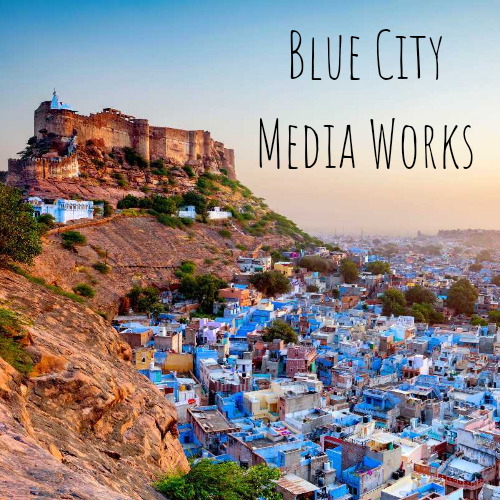
I started editing on the HP PC provided by school as we were visiting school for the editing part along with our teacher and my team mates. For the AS I edited on my laptop as well as the school’s PC using Adobe Premiere Pro 2020 it was very difficult to edit on my laptop as premiere pro kept hanging along with my laptop and there was even a time when the whole software was found corrupts. So this time I’ll use the School’s Pc only. I watched trailers of films which reflects domestic violence issues along with crime/drama trailers. It helped me to gain knowledge about what all elements a trailer should contain and what constitutes a trailer like high tempo background sound, fast cuts, low key lighting etc. which I have to keep in mind while editing a Crime/drama genre trailer. As I used the same software for my AS I had already had the basic Knowledge of the software.
I started with importing files of my trailer on the software and then brought them on the timeline, extracted some parts from the trailer which I and my director found appropriate for the trailer. Then parallelly we started searching for the background score to use in our trailer using YouTube. Our trailer will require soundtracks of different paces as we planned to keep our first trailer slow paced and the second one with a fast tempo. We wanted to use a background score which gives the feeling of Rajasthan and desert something like sounds of Ravanhattha or may be sarangi.
RAVANAHATTHA

SARANGI

After a lot research we found this song called choti si umar it has a sarangi tune in the beginning and we only took that part of the audio file, which we are going to use for our first trailer along with several other background scores. While editing the trailer I got to know that in trailers clip are matched according to the sound and not the other way around. This is because the sound have certain variations like high tempo, slow tempo and etc. That is why we have to put the appropriate clip-on that sound effect so that it makes that specific scene more eye-catching for example a peaceful will be matched to the sound which has a low tempo. Then we searched for a trailer music to create that feeling of building up tension. Our teacher suggest some of the sounds to us and we finalized the music from them. We were done with the work of background scores. Till this time I had made the first draft but that sequence didn’t look good. So me and my director revised both the sequences. And brainstormed about the new ones. For that we again watched trailers of some movies like:
ARTICLE 15
youtube
PINK
youtube
THAPPAD
youtube
SECTION 375
youtube
DHANAK
youtube
SECRET SUPER STAR

KAHAANI

And while doing that we realized that we should add some impactful text in our trailers similar to article 15 which was quit impactful. Then we researched for the facts related to child marriage and Domestic violence in support of our story.
We researched several facts on the social issues which our story is dealing with so as to have enough proof of our stories authenticity. Some of them are:-
-Child Marriage Act (PCMA), 2006 declares child marriages are illegal.
-As high as 47 percent of the girls in India are subject to marriage by 18 years of age.
-India is home to 1/3 of the world's child brides.
-UN Population Funds says more than 140 million girls will become child brides by 2020.
-27% of women experience physical violence since the age of 15.
-In 2017, 32 percent of girls were not enrolled in school in comparison to 28 percent of boys.
Our teacher also told us to start focusing on our CCR questions from now.
0 notes
Text
How to Post your Works to the SQSupernova Collection!
That’s right - it’s almost time for Authors and Artists to put their beautiful works on display! We’ve made our beautiful, wonderful guide to help you post your work successfully - please read it THOROUGHLY before asking questions! We promise we’ve covered almost anything that could cause issues.
The posting deadline for all works is midnight EST on August 31st!
(What time is that for me? Or, check out our Countdown Timer!)
For those of you with experience posting to the Swan Queen Supernova collection from previous years, this year’s collection can be found HERE - just hit the ‘post to collection’ button and away you go!
Quick reminder - don’t forget to click POST when you are done formatting your work, NOT ‘save as draft’! We will not be able to see or reveal your work if you save it as a draft, and it will not count as being submitted!
For those of you who need more assistance as you prepare to post, , read on for more specific instructions:
All right! For those of you who would like further clarification, your first step will still be to go to THIS LINK and click ‘Post to Collection,’ as seen below.

On this next page, you will enter all of the information about your fic/art - starting with rating, warnings, fandom, category, relationships, and characters. A sample page would look like this:

Please make sure your rating and warnings are accurate to your fic/art. If you think a warning might spoil something for the plot, you can select ‘Choose Not to Use Archive Warnings.’ Do NOT select ‘No Archive Warnings Apply’ unless your fic/art truly does not have any of the warning elements present in it.
The Additional Tags section is a place to put anything else you feel should be indicated about your story/art. Is it a historical au? Does it take place on a spaceship? Is it fluff? angst? crack? These tags are optional, but many people do use them to organize their fic/art or to find new fics to read and art to appreciate.
Next up is the preface section - this is how you introduce your fic or art!

Authors - you’ve already sent us a title and summary, so if those still work for you, go ahead and just copy them right in there! If you’ve changed some things up since that submission, go ahead and put your final version in here.
Artists - whatever title you use, it’s probably a good idea to add [Fanart] or [Art] to the end of your title, and to tag it as such in the additional tags as well - this will help people find art specifically!
Notes can be posted at the beginning of the fic - like if you are thanking a beta, or blaming someone for making you do this, or giving introductory notes to the readers about setting, etc - or at the end of the fic, if your notes might spoil part of the plot. You can also check both boxes and put notes in both places!
Now for the fiddly bits:

The first, and most important, thing to check is that under Post to Collections / Challenges, ‘SQSupernova5′ is selected. This should automatically show up, since you used the ‘Post to Collection’ button, but please check anyway!
You can also choose to gift your fic to someone - authors may choose to gift their fic to their artist, or vice versa. You should have their AO3 name from your match-up email!
‘This work is a remix, a translation, a podfic, or was inspired by another work’ - this will be a handy section to connect your fic to your artist’s art, but you won’t be able to use it until after reveals. Skip it for now and come back to it later, once your partner’s work has been revealed!
‘This work is part of a series’ - if your SQSN was part of a series that you have already begun, you can link it to the previous parts here. Otherwise, skip it.
‘This work has multiple chapters’ - If you’d like to split your work up into chapters, select this option. Once you post the first chapter, you will be able to add additional chapters from the first chapter of your fic/art.
‘Set a different publication date’ - DON’T DO ANYTHING WITH THIS NOW. LEAVE IT ALONE. You will receive instructions in your reveal date email about how to change this date later, to help ensure that it shows up at the top of the Swan Queen tag, so you get the most eyes on it. You cannot change the date BEFORE the date of your reveal, so leave this field alone for now.
You’re almost there! First up are some privacy questions:

These are all options that can make it harder for people to leave mean or abusive comments - but they also make it harder for commenters without accounts to leave feedback, so consider the pros and cons before selecting!
And finally, it’s time to input your fic or art!

For fic - if you are comfortable with html coding, feel free to use the HTML editor button in the top right to switch editing boxes. Otherwise, the Rich Text editor will let you do most basic word editing functions, and will maintain bolding, italics, etc pasted in from Word or Google Docs.
For art, you will need some words in the post itself in order to post, so be sure to add a sentence or two about your work, then select the insert/edit image button:

It will bring up this menu:

Source - this is where you should paste in the url of the image you are hosting on another private site - so don’t publicly post it to your Tumblr! Use a PRIVATE post, at least until reveals are over. For a list of recommended sites, check out AO3′s helpful article on the subject!
Remember that your image URL needs to end in a filetype, like .jpg, .png, .gif, etc etc.!!! IT WILL NOT WORK IF YOU DO NOT HAVE A FILETYPE AT THE END OF YOUR URL. Your image will NOT appear if your link ends in .html, /, or any random numbers or letters.
Image description - this is very important for people who use screen readers because of vision impairments. Please describe your image as best you can, for example: this is a four-panel cartoon of Emma Swan, a barista, tripping over a chair and spilling hot chocolate down Regina Mills’ shirt. Regina is in a fancy blouse and skirt, and looks very, very pissed off.
Dimensions - if your source image is very, very big, it is recommended that you shrink it down a bit here. You can always come back and play around with the size once you post, so be sure to check that your image isn’t so big it’s hard to see all of it on a normal computer screen.
Aaaaaand, you’re done! If you’re confident everything is correct, you can click ‘Post Without Preview’ (you daredevil, you), but otherwise, click ‘Preview’ and give your story a quick glance over to make sure everything’s in the right place.

Then, once you’re satisfied, just make sure you click POST on the next screen - this is the only way to submit it to us for the collection!

If you don’t click ‘Post,’ your work will stay as a draft and will NOT be counted as submitted! Please make sure to hit POST once you have everything ready.
Once you post your work to the collection, it immediately becomes an unrevealed work. This means that its details are hidden from everyone but you and your beloved mods! Unfortunately, this also makes it a liiiiittle harder to find.
To locate your work once you post it to the collection, go to ‘My Dashboard’ by clicking on the menu that appears when you click on your username in the top right corner of the page, then click on ‘Works’ on the left-hand side.
From here, you can access your hidden work in one of two ways:
Click ‘Edit Works’ on the upper right side of the page. This will let you view all of your works, sorted by fandom, including the one you just submitted to the collection. Click on the title of that work to continue editing it!
Click ‘Works in Collections’ on the upper right side of the page. This will display all of your works that are currently in collections, sorted chronologically. Your SQSN work should be at the top, with “Unrevealed:” in front of the title. Click on the title of that work to continue editing it!
The URL of your work will also not change once you’ve clicked ‘post,’ so you can also bookmark or save it to come back to at any time.
If you need to add additional chapters to your work, you can do it by going to that URL or locating your fic again as described above, and clicking this link on the first chapter:

Just make sure to press POST on each additional chapter as well! ;D
--------------------
Congratulations! You’ve just Supernova’d! What a rush, eh? Now just lean back, relax, and wait for reveals. Thank you for participating!
Each creator will get an email letting them know the reveal date for each work they have submitted, at least a few days before the date, so that they can prepare and get their friends hyped up for the reveal! If you hear other people getting their emails and you haven’t yet, don’t panic. There are WEEKS of reveals, so some people get emails very early and some people get emails weeks later. We PROMISE everyone will get an email with their reveal date by the time all is said and done!
If you have any questions, feel free to contact us at @SQSupernova on Twitter, or at [email protected] !
8 notes
·
View notes